
|
SEEKING ADVENTURE? |
|
Zane Mirfin Fishing Articles 2013
Treasured river deserves respect.
Zane Mirfin, Wildside Column, Treasured river deserves respect, 14 December 2013, Nelson Mail
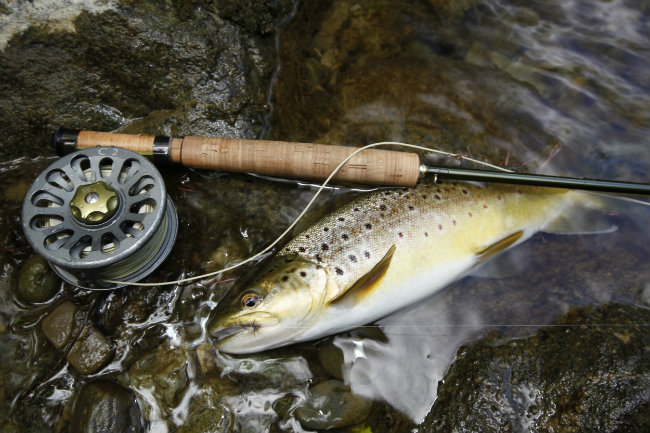
Life and Hope: A Maitai River brown trout caught on a No. 14 parachute adams dry fly.
Once upon a fishery there was the Maitai River. It was a beautiful stream, overhung with willows, clear pristine water, silver gravel, and teeming with wild brown trout.
The fishery was important to generations of Nelson trout fishermen, especially junior anglers, because it was close to home, small, safe, and very special. Many other people in the community valued it also, as a place to visit, bike, walk, picnic, play, swim and enjoy.
As a boy, the river was the apple of my eye, a place of joy and wonder, and probably my first love. It was a valuable training ground where I learnt my craft as an angler, where early success propelled me onwards and upwards in what was to become a lifelong angling quest.
My story is not unique and many people in our community valued the Maitai River, and still do, but one day the river got sick, the trout disappeared, and people couldn't even swim in the river any more.
The Maitai has always been an iconic provincial treasure, a silver thread that winds through the heart of Nelson City to the Haven, but the sad environmental status of the river has drained much of the magic from the catchment for many people. For years I've avoided fishing there, preferring to remember the river as it was during those idyllic boyhood fishing days of the early eighties.
They were great days, exploring the river on foot, learning life's lessons and having all manner of fishing adventures. We'd fish the river whenever we could, at weekends and after school. Often during school holidays Mother Sherry would drop us off at the Maitai while she went to work in Nelson City, and where we would spend the day fishing upstream to be picked up later at a specified time on the valley road.
What went wrong with the Maitai fishery and the health of the river is a debatable topic. Was it forestry operations in tributaries Sharland and Packers creeks destroying valuable spawning habitat and nursery areas? Was it the Nelson City Council North Branch Maitai Dam? Was it the golf course with herbicide and insecticide use? Was it urban intensification and population pressure? Was it all of these factors and many more? Whatever the reasons, the river is still in bad shape, the latest drama of recurring bad environmental health being cyanobacteria infection, meaning swimming for dogs and humans is off limits.
Recently there has been much mention of the Maitai in the Nelson Mail. It heartens me that other people care about the river, as I do. The formation of "Friends of the Maitai' led by Ami Kennedy is a welcome outcome, and a group I hope many of us will join to do our part in the restoration of this iconic Nelson jewel.
The Maitai has been on my mind lately, and on Wednesday after coming home from a meeting about another river catchment, I just had to go fishing. No-one was home and I was like a little boy excitedly throwing gear in the truck and heading for the Maitai Valley, a little more than a 30km round trip from downtown Richmond.
Parking under a shady tree I pulled on waders known in the trade as a "full-body condom" to protect me while wading in the apparently toxic waters. I strung my rod together, retied the leader, and attached a size 14 parachute adams dry fly. For some reason excitement overcame me as I struggled to tie the knot with shaking fingers.
As I used the reflection in the truck window to rub sunscreen on to my face, I saw the man and angler I had become, and wondered what myself as a 13-year-old boy would have made of the gear I now wore, the knowledge I now had, and the fishing experiences I had enjoyed around the globe.
I realised that the humble Maitai was more than just a river to me, it was a living beast that had ignited passion and desire, a fly fishing stepping-stone that had created meaning in my life and kick-started a professional fishing guiding career spanning 28 years and counting.
Clambering down an overgrown bank, the stream was much the same as I remembered, although the water was darker, smelt bad, and the river was more slimey with algae.
It was difficult wading, slipping and sliding, on the treacherous slick bottom but I threw a few exploratory casts upstream in the eternal hope of catching a fish. I wasn't expecting much and after 20 or 30 casts in several nice slicks, runs and pockets, I was resigned to failure.
The next cast the dry fly sat up nicely and bobbed along a promising edge, as a trout rose from nowhere and sucked down the fly. I don't know who got more of a fright, me or the trout, but it was fun, just like the old days. The brown trout ran, jumped and splashed, giving me great joy as I admired the beautiful wild trout before release.
A man renewed, I realised that the river wasn't totally dead, and that life did indeed still exist in the Maitai River. I fished upstream, even managing to catch a few more, mostly small, but all colourful and in seemingly good health.
At the golf course, a shed has been built against the river and as I walked around it, a man from the shop approached me and told me I couldn't fish the river. "Why not, it's a public river," I said.
"It's our liability if you are killed with a golf ball," he told me. "But you haven't given me permission so you have no liability," I answered back.
"We don't want the trout under the bridge caught because the members feed them bread," he told me. "Well, I'm a catch and release angler and I'm not going away," I replied.
It was becoming somewhat of a Mexican standoff when I decided to introduce myself and explain how I was fishing the river for Auld Lang Syne. It turned out my new friend was a really good guy who invited me up on the bridge to watch three resident trout as we discussed the Maitai River of old.
Soon it was time to move on and we cordially shook hands, before I walked upstream 100m leaving the golf club fish feeding in peace.
I enjoyed my recent Maitai fishing experience and while I won't be rushing back to fish it again anytime soon, it was pleasing to know that at least some trout still exist in the degraded waters. I even scored a few golf balls for my kids from the stained river. The river banks looked good with many areas of thick riparian cover protecting the river, maybe even better than in my youth.
There were still pockets of good habitat for trout although much of the river was scoured out and could do with rehabilitation. Restoring a stream to health is not impossible and is routinely undertaken in the United States and Europe by individuals, organisations and communities that care.
Mike Ward is a colourful Nelsonian, a man of great wisdom, and in some ways light years ahead of his time. In the Nelson Mail recently he wrote that "Our planet didn't just overheat and the forests didn't just disappear and our rivers didn't just run dry and get polluted by themselves - these things happened because too many of us spend too little time thinking about the consequences of the choices we make".
Mike is so right, and we do need to choose to protect our rivers from harm and neglect.
While it's true that New Zealand lowland rivers, including our iconic local Maitai, have had one hell of a hiding over recent decades there is always hope for the future.
Bureaucrats, politicians and industry may well make environmental progress in the years to come but it is up to communities to take the driving seat and demand clean, clear and safe rivers from those who would pollute and destroy.
Here's hoping our community can restore and protect the Maitai River so our kids and grandkids can enjoy the river, just as we did.
Sea-run trout a true treasure
Zane Mirfin, Wildside Column, Sea-run trout a true treasure, 16 November 2013, Nelson Mail
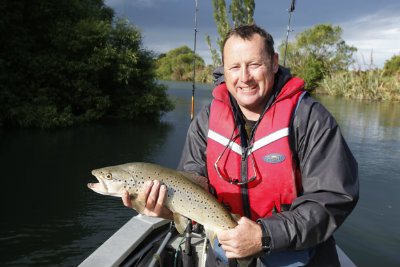 |
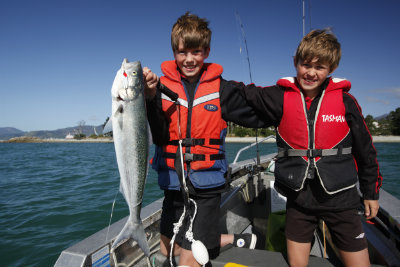 |
| Rewarded: Lawrence Schicker of the North Island with his first South Island "nomad of the tide". | After-school fun: Digby Carroll of Wellington with a nice Kahawai caught in Nelson Harbour with guide Izaak Mirfin. |
Utilising waterways throughout their length, from pristine headwaters to estuarine and coastal waters, migratory anadromous brown trout have populated virtually all the water ways of the Dominion since the late 1860s.
These highly mobile trout use estuarine and coastal waters for feeding, forage, and recuperating from the rigours of spawning during spring and summer, while traversing upland toward alpine waters during late summer, autumn, and during winter spawning. Along the way they give us Kiwi anglers plenty of chances to fish for them too.
Sea-run trout is really just another name for the ever popular brown trout (salmo trutta), of which some populations are very territorial while others are highly migratory, utilising saline coastal waters for a portion of their lifecycle. To this day, the full extent of the sea-run trout resource is unknown and unmapped.
Scientific funding of salmonid studies within New Zealand is limited, some would say stunted, and the influence of estuarine and tidal components on our modern trout fisheries are woefully and inadequately understood by fisheries managers, bureaucrats and politicians.
Fortunately, we have the Cawthron Institute here in Nelson performing world-class science right on our own doorstep. Dr John Hayes is an acknowledged expert on salmonid behaviour and fisheries, and a pretty good shot on Californian quail when we've hunted the riverbeds of Marlborough in winter.
Co-author of The Artful Science of Flyfishing (2005) with former Nelsonian Les Hill, John Hayes wrote that "in colder climes the fish forsake the cold rivers for the relatively warm ocean and its greater food resources".
John also notes that "one thing is certain: while at sea or in the estuary, they grow extremely fast". So fast in fact that South American sea-run browns regularly reach 10-15kg and bigger at Argentina's famed Tierra Del Fuego.
Sea-run trout are a worldwide phenomenon and my favourite British fishing book on the topic is The Book of the Sea Trout by Hamish Stuart. Written in 1917, Stuart described sea trout as "nomads of the tides to whom all watery ways are familiar".
I've been fortunate to fish for sea-run trout throughout the South Island, in Nelson, Marlborough, West Coast, North Canterbury, Central South Island, even Fiordland. Fond memories exist of fishing the rivers of Westland by raft and jetboat over the years and in rivers like the Karamea, Mohikinui, Buller, Grey, Taramakau, Hokitika, Wanganui, Karangarua, Paringa and Haast.
It's been an awesome wild adventure but my other experiences of the East Coast rivers are just as memorable fishing rivers such as the Clarence, Waiau, Hurunui, Waimakariri, Selwyn, Rakaia, and Rangitata. Wherever you go in the South Island you can find always find a sea-run trout somewhere near the coast.The estuarine areas of our lowland rivers are some of our most accessible freshwater fisheries, close to civilisation, having excellent access provisions. Such areas may not have the visual appeal of some of our better known headwater fisheries, but offer some fabulous fishing opportunities with glorious sunrises and sunsets within a short drive of our homes.
All legal methods such as fly fishing, spinning, trolling, bait-fishing, jigging, and soft plastics will work given the right application in the right situation. Being adaptable is the key to success, especially when introducing youngsters to the sport of trout fishing.
Sea runners are secretive and predatory creatures, best pursued during the change of light or during the hours of darkness. Prior knowledge of where you are fishing is essential after dark, especially where river crossings and tidal flows are involved. High river flows when falling after a flood are great times to fish and trout will likely be catchable all day in discoloured waters.
Sea runners are an active fish that can turn up pretty much anywhere. On larger rivers, you will have to fish wherever you can get at the river and we now do much of our lower river fishing from boats to access lightly fished locations overgrown with vegetation and other hazardous obstacles to wading.
Where the first major rapid around or above the tidal push occurs is always a great place to encounter sea runners as this is a natural trapping area for ascending baitfish, such as smelt, whitebait, mullet and small crustaceans such as shrimp. Trout will be present near heavy cover, such as willows, snags, or holding in deeper channels, undercuts and weedbeds.
Estuarine trout are fickle creatures that are always present because of the food. If there are limited quantities of baitfish around then there is likely to be few trout around. Sea runners are notorious for being present one week and gone the next. You can be doing everything right, but if no fish are in residence then the catching will be lean. But don't give up, try again next week and some fresh fish may have turned up.
It can be exciting fishing when you can hear or see trout working the surface, experiencing bow-waves, swirling and jumping fish but often you have to go deep too. Lowland rivers have plenty of snags in the form of willow trees, old cars, and gorse bushes bought down from the last flood so be prepared to lose lots of terminal tackle. I like to use flies that are fast and easy to tie to avoid tears when the inevitable snags occur.
Just last week North Island's Lawrence Schicker hired me to teach him the ways of the sea trout. By early afternoon we'd had no luck and I needed a game changer to get us on the scoreboard fast. Retreating to another river and adapting our technique Lawrence was into his first tidal brownie within minutes. It was a great second half and by the time we had the boat back on the trailer Lawrence had landed 7 trout, including one beauty that he reverently took home for mounting by a taxidermist.
Lawrence marvelled at the savagery of some of the hits and the way the estuarine trout fought with surging runs and acrobatic leaps clear of the water. Mark Twain may well have described the act of fishing as "a piece of string, with a jerk on one end waiting for a jerk on the other", but he probably never caught many sea trout. Kurt Olesek, of Colorado, had some good fishing with me last week, too. Kurt had excitement written all over his face when yet another silver bullet impaled itself onto his swinging fly and took off downstream in an attempt to change postal codes. "The tug is always the drug," he enthused to me as we chased the trout downriver.
Another great thing about fishing tidal waters is the nearby presence of kahawai, especially during warm summer water temperatures. Kahawai are a great fighting saltwater pelagic fish species that travel in shoals and are voracious feeders.
They will take on the incoming or outgoing tide and are great fun on light tackle, being very tasty bled when first caught, and either smoked, or made into fish cakes or pies.
My son Izaak had read all about the recent kahawai frenzy visible from Nelson's Rocks Rd in the Nelson Mail and was insistent we take his school billet, Digby Carroll from Wellington, fishing last night.
Ike had a quick troll in the lower Maitai for a sea-run trout before we raced out into the Haven headed for Fifeshire Rock. There were no birds working the surface but the kahawai were there in numbers and willing to take a small silver ticer trolled behind the boat.
Digby and Ike had a blast reefing in great fish on light tackle, with epic battles and big leaping kahawai. It was a unique after-school adventure so close to home, with the Port Hills lit up in the afternoon sun and rush hour commuters jamming up the road.
Gone Troppo' up in Queensland
Zane Mirfin, Wildside Column, Gone Troppo' up in Queensland, 2 November 2013, Nelson Mail
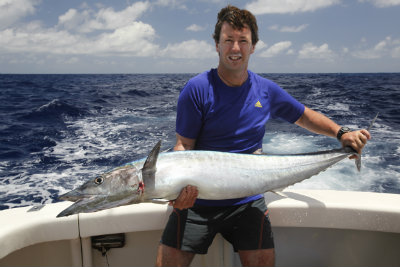 |
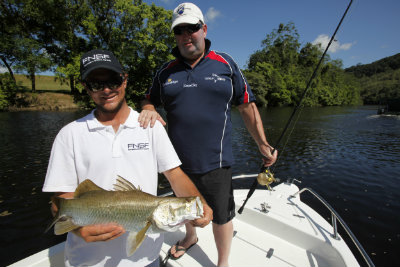 |
| Heavy Landing: Zane Mirfin with a Wahoo caught trolling at Linden Bank, Coral Sea, Northern Queensland | Catch of the Day: Garry Munro, right, with guide Casey and a barramundi from the Daintree River |
Flying over parts of the reef en route to Cairns gave tantalising glimpses of a hidden world of white sand islands, shallow coral outcrops and breathtaking water coloration. Tropical fishing locales are always exciting and kicking back into island time and going "troppo" was all part of the plan.
I was flying north to help friends Tony Fyfe and Craig Parsell test their new tourism concept fishing the remote coastal and inland waters, north of the resort town of Port Douglas.
Wild waters await anglers from Lizard Island toward Princess Charlotte Bay, around Cape Melville, and as far as the Lockhart River.
Our plan was to take their large custom-fitted "mothership", Blue Martini, complete with skipper, chef and guides, and tow three fishing dories north on an epic journey of fishing exploration.
Scott Wallace of Christchurch and Gary Munro of Trailways Hotel fame here in Nelson had also made the pilgrimage. It was a great team and it needed to be because as soon as we arrived everything started to go pear- shaped.
First it was engine problems, then overheating issues, then water problems, electrical problems, bilge problems, crew issues, you name it.
Tony and Craig are skilled entrepreneurs and businessmen but we soon realised that there was a lot more work to do before their vision of offering the best fishing experiences in Australia could be realised. We lost a few days trying to rectify all the issues before accepting that Blue Martini was not going to leave port.
One of the best qualities of successful people is being able to come up with a Plan B at short notice and Tony and Craig turned on an awesome adventure for us based from Port Douglas. We had a huge store of liquor on the boat, a fully stocked coolstore with luxury food, top chef, guides, and a good attitude. Nearby we had top bars, restaurants, cafes and resort swimming pools. It was a match made in heaven and a bunch of forty- something guys behaving badly was lots of fun.
Our first fishing outing was to take the dories from Port Douglas across the bay to the Mossman River. We crossed the river bar and headed upstream into a tropical wonderland of mangroves and lush jungle, complete with fruit bats hanging upside down and crocodiles lounging on muddy edges.
We were after the legendary barramundi, an iconic freshwater and estuarine fish that thrives around coastal and inland Australia. Barramundi are an ambush fish and fishing involves luring and teasing them from their lair under mangrove roots, logs, snags, weedbeds and shady areas.Tony fished with baitcasting tackle, braided line and gold-coloured rapala "husky jerk" lure while I cast with a sink tip fly line and various large clouser minnow-style flies. We pounded the waters to a foam and Dave our guide tried hard to put us on to good locations without a strike. I persevered , eventually being rewarded with a tug and splashing silver fish that turned out to be a tarpon and our only success.
Our first saltwater fishing experience was out on the Great Barrier Reef at a spot known as Agincourt reef. Blasting out across the coastal waters sheltered from ocean swell from the reef, we could see green reflections in the clouds as we approached the shallow waters surrounded by deeper blue seas.
Drifting in close we pounded the reef with big popping lures that glugged and chugged across the surface at speed trying to attract the prized GTs. Giant trevally are an aggressive pelagic reef species that prey on any small fish unfortunate enough to be in their way and while we saw a few GTs they were unimpressed with our lures and a spanish mackerel was our only reward.
Heading out deeper we did some jigging with Tony catching a big golden trevally. The other guys fared better on the other boat catching some mackerel and tuna before the action dried up. Heading back closer to the reef we attempted some bait fishing with pilchards along steep drop-offs and managed to catch at least half a dozen different reef species including the colourful and tasty coral trout - a beautiful red-sided fish covered in bright blue spots - which are a treasure to behold.
Big boat hassles kept us close to base, but one day we drove to the town of Mossman to look for engineering supplies. On the way back, past sugar cane fields, and Aboriginal residents, deckhand Casey pointed out a small stream that reputedly held fish called jungle perch. It was back to the boat for a fly rod and Casey and I were soon stalking the jungle banks peering into shaded pools with a trickle of water between. It was fun sneaking through the trees, on the lookout for poisonous snakes, while wild mangoes hung low on trees, and mysterious birds whooped from high above.
I was totally overgunned with an 8 weight flyrod, heavy saltwater leader and flies that were much too large. The fish were numerous, often in schools, and they would charge up, look at the fly, and bolt for safety. It was exciting sight-fishing and with a lightweight rod, line and trout flies, I would have caught many fish. Although I was unsuccessful, fishing the rainforest was something I'd love to try again.
One afternoon we took the boats out to Low Isles, a marine reserve on the reef where we snorkelled among intensely coloured fish, anemones, sponges, fans and coral. The diversity of colours was amazing with just about every colour of the rainbow present. I marvelled at the big clams snapping shut as I swam over them and the coral structures shaped like a brain with intricate maze-like patterns.
Next day we journeyed across the bay toward the Daintree National Park. As we blasted up the Daintree river in search of barramundi, large crocodiles surged over the land toward the water.
We pounded the waters of the Daintree and hooked four barras from our boat, only one of which made it onboard for a photo. After the last hookup, near some big crocs, it was time to go and I made a last errant cast into a mango tree. As I was trying to pull the lure free, Casey hit a log and had to gun the motor in reverse. My bare feet skidded on the fibreglass forward deck and I was propelled head-first into the Daintree River. Coming to the surface in a hurry knowing I was in real danger of being crocodile bait, I saw the alarm in the faces of Gary and Casey as they grabbed my up- stretched arms and hauled me up the steep side of the boat.
Perhaps our last day of fishing was the best. Out through numerous reefs on the gamefishing boat Saltaire, our destination was the famed Linden Bank, 70 kilometres from land, in the Coral Sea. Also known as "The Carpark" because of the numerous gameboats invariably in residence, the rise is on the edge of the continental shelf with rich fertile upwellings, with huge quantities of baitfish, that attract all manner of gamefish including black marlin, sailfish, spanish mackerel, wahoo, and mahimahi.
Linden Bank is world famous for producing more 1000lb marlin than all other spots in the world combined and everyone else was trolling for marlin. We chose to fish for smaller species with surface lures and tuna skirts deployed from outriggers. Flying fish jumped and glided ahead of the boat in the most incredible blue ocean water I had ever seen. Big bait balls showed up on the electronic screen on the top deck as skipper Damian explained all manner of fishing lore and technique to me. The fishing was slow due to a full moon phase and not one marlin was hooked that day while we managed only two fish for the day, both 20kg or so. Gary caught a spanish mackerel, while I was fortunate to wind in a powerful wahoo but it was a magical day out.
Maybe our fishing trip wasn't as stellar as we had hoped but it was still the experience of a lifetime. The bright lights of Brisbane and the Treasury Casino were still to come as we planned our next visit to fish with Far North Sport Fishing aboard Blue Martini. I'm really looking forward to "going troppo" again, and who knows, next time we might even leave port.
Catcher on the Fly
Zane Mirfin, Wildside Column, Catcher on the Fly, 19 October 2013, Nelson Mail
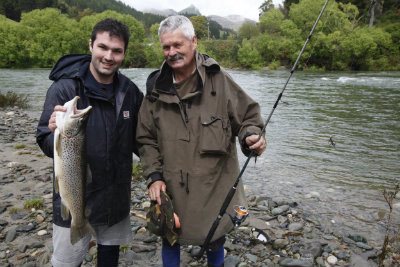 |
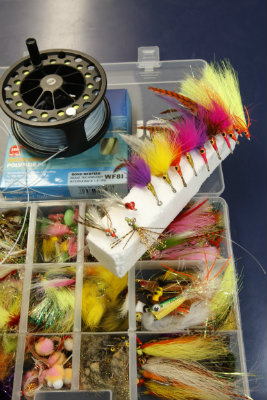 |
| To tie for: Tom Maling, left, and Kit Maling with a Motueka brown trout caught on Monday. Tom fished using homemade flies with a braided line. | Feathered friends: saltwater fishing flies |
"When you look at your flies, your eyes start to spark," she told me and maybe she is right.
I've always loved the mysteries of fishing and attempting to solve the riddles of nature. Making your own flies is something you can do at home, escaping into another world where you can dream, fantasise and create. Some of my tying efforts have also caught a lot of fish for me, family, friends and my fishing customers ever since I first began fly tying as a 10-year-old boy and anything you can do to give yourself a 1 per cent edge is well worth doing.
This week Richmond's Kit Maling was insistent we go fishing. In three years of friendship we'd never been trout fishing together, and with Kit's son Tom down from Auckland, they were keen to give it a go. Rivers were high on Monday with the MetService's Daniel Corbett describing the day as "wet, yucky and windy" so we went anyway.
Conventional fly fishing appeared futile so we fished heavy Mirf-tied flies on braided line. Modern synthetic braided lines give superior bite detection and by using weighted flies tied to imitate crayfish and bullies, using rabbit fur and rubber legs, we enjoyed modest success in challenging conditions.
Some of the bugs we fished came to life in the water and looked so good that you could almost be tempted to eat them yourself. After lunch the weather deteriorated rapidly, with rain, thunder, and impressive lightning bolts shooting earthwards. It was time to go but we had proved that you can catch fish on flies in some pretty diabolical conditions.
Recent flood damage to the lower Wangapeka and Motueka rivers was impressive and we just keep getting these high-intensity storms which do so much damage to this nationally important fishery through scouring and sedimentation.
Poor land management hasn't helped and in many places we are fortunate to have introduced plants like willow, wattle, blackberry, broom, and gorse to hold riverbanks together.
All tributary streams were up and coloured, but streams that have almost always flowed clear after heavy rain, like the Pearse, Graham and Pokororo, were running deathly white and milky.
Luckily there is still the ocean to fish, and as our lowland rivers continue to implode locally and nationally, many of us will increasingly turn toward the sea. Saltwater fish love eating flies too and saltwater fly fishing is becoming increasingly popular around the world.
Modern travel has opened up a huge number of exciting new saltwater venues with sight fishing in tropical locales like Venezuela, the Bahamas, Florida, Mexico and Kiribati offering world-class fishing for large fish on light tackle.
Closer to home, tropical waters north of the Great Barrier Reef in Australia offer exceptional fishing only a few hours' flying time from home.
Wading the tropical flats with fly rod in hand has to be one of the greatest fly fishing experiences on earth. The azure marine water lapping white limestone flats of remote equatorial atolls is amazing. The water is clear and pristine, with fast, large and highly specialised fish adapted to shallow flats, beaches, lagoons and cays. Dropping the fly ahead of cruising fish, the fly is slowly or quickly stripped back to the angler until the fish pounces and a connection is made. Hooked fish bolt for safety with mind-altering speed and adrenaline-laced runs as the rod is almost ripped from your grasp and the reel screams in protest.
Modern saltwater fly fishing gear has come a long way since the ancient Macedonians first invented fly fishing, and high modulus graphite and other space age materials have allowed anglers to pursue fish never before contemplated with a fly rod.
Fish such as bonefish, permit and tarpon are coveted targets but nowadays fly fisherman also catch large sharks, sailfish and even marlin on the fly.
Saltwater fly rods are generally much heavier than trout fishing gear, with 8, 10, 12 and even 14 weight rods common in the salt, although the larger weight rods take a strong arm to cast all day.
Flylines help cast the relatively lightly weighted flies, and they come in many floating, sinking, and intermediate configurations, being attached to tapered leaders which connect flies to the flyline.
Leaders are usually tied with fluorocarbon material which has a higher refractive index than monofilament and is far less visible to fish in the water as well as sinking faster and being more abrasion resistant.
The flies themselves are amazing, most tied with dumbbell eyes, weight, flash, and colour, in different sizes and often on stainless steel hooks.
Fly materials range from natural fibres such as bucktail and marabou, through to synthetic flashabou, krystal flash and polar fibre. They imitate anything from crabs, sea worms, baitfish, snails, shrimp, squid, you name it.
Fish can be very selective and the closer you match what they are eating, the more successful you will become.
Some of the best known styles of flies are known as crazy charlies, gotchas, deceivers, clouser minnows, and even surface poppers. Some sink, some float, and all of them catch fish.
The tropical environment is extremely harsh with the need for plentiful sunscreen and bug repellent. Solid footwear is required to avoid coral cuts, rays, sharks or stepping on dreaded stonefish with their poisonous spikes. Most anglers wade the shallow flats equipped with sunglasses, long pants, long sleeved shirt, wide-brimmed hat, and buff (cloth face shield) to keep the relentless tropical sun and wind at bay.
Back in the mid-1990s I was privileged to fish the amazing waters of Kiribati in the equatorial Pacific.
Christmas Island was "discovered" by Captain Cook on Christmas Eve 1777 and was later a strategic staging area for Allied forces in World War II, before becoming an American nuclear weapons testing site during the 1950s and 60s.
Not much remains of this history but, at 360 square kilometres, Christmas Island is the largest atoll in the world with eye-poppingly beautiful lagoons and ocean-side fisheries, complete with coral reefs and hungry fish.
Bonefish were the prime quarry, a metallic and silvery fish with a downward facing mouth that is superbly adapted to shallow water environments.
Cruising the shallow flats in search of food, individual fish would spook at a bad cast, but when fortune smiled and the cast was good, hooked bonefish would bolt for the safety of the deep ocean sometimes ripping up to 150 metres of backing off a reel.
The other glamour fish were giant trevally that would appear occasionally as dark, menacing shadows along deep drop-offs. A quick long cast before stripping the fly as fast as humanly possible would see a mad dash by the trevally, a heart-stopping strike, and the angler attached to a fish that resembled a freight train.
Many fish could not be landed, with trevally regularly cutting flies off in the coral but it didn't matter because it's all about sport, and the angler who lost the most flies won.
Many Kiwi anglers will travel overseas to fish azure tropical waters in the years ahead and many Nelsonians, including Cameron Reid, Chris Jackson and Henry Sulser, already regularly fish the famed Pacific waters of Aitutaki for bonefish.
My next personal tropical fishing experience is the iconic waters of northern Queensland for exciting new reef, river and bluewater species. I've tied plenty of great flies, my eyes are beginning to spark, and I just can't wait.
South Island boat Ramps & Access
Zane Mirfin, Wildside Articles, Ramped up stories, Nelson Mail, 24 August 2013
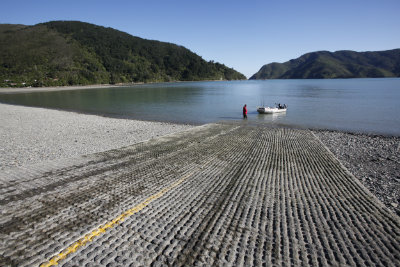 |
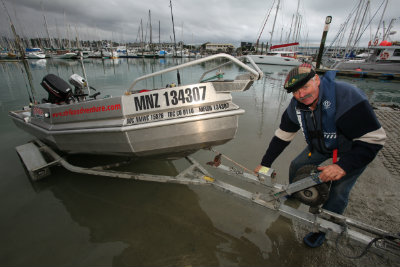 |
| Stairway to Heaven: Lonesome boat, Okiwi Bay Ramp at Croiselles Harbour in the Marlborough Sounds. | Nelson City Launching: Kit Maling of Richmond assists to launch Strike Adventure. |
Out fishing this week with Kit Maling of Richmond got me thinking about the great range of boat ramps we have here in the top of the South.
With the generally favourable seas of Tasman Bay, boating is popular and public boat ramps lie to virtually every point of the compass, in different sizes, shapes, and configurations.
Some are as rough as guts with rutted gravel and mud launching slopes while others are deluxe concrete affairs with toilets, truck and trailer parks, even boat wash-down facilities.
Heading out of Port Nelson this week was a pleasant experience. First stop was to call by the port marina office to buy another annual pass to the Akersten St boat ramp. Having an annual ramp pass saves a lot of time filling in vehicle and trailer registration numbers every time you use the ramp and avoids the hassle of attempting to find $5 notes in your wallet.
I stick my annual pass ticket onto a piece of plastic ice-cream container lid so I don't lose it, leave it in my vehicle to place on the dashboard, and can be launching immediately the moment I arrive at the ramp.
Having launched boats at many ramps over the years like many others, I've been witness to many strange events and bizarre examples of human behaviour at public ramps. Most people are well behaved and respectful of others but others can be irritating and annoying to all by blocking ramps, holding up launching traffic through disorganisation, inexperience, arrogance or ignorance.
Fishermen are always in a hurry to get their boat into the water and being organised with good systems means you can spend less time on the ramp minimising the chances of upsetting someone else. When there is a queue to get down the ramp to launch, tempers can get frayed fast and people can even explode in anger.
I've had my own moments of frustration, like the time I was involved in a shouting match at a Lake Rotoiti ramp, or another time when someone backed their boat into my truck at the Havelock ramp, smashing a headlight. Luckily, increasing age and wisdom have a mellowing influence, and I'm a lot more relaxed and patient when it comes to getting my boat in and out of the water these days. Overseas, angler clashes at boat ramps are common, and it is a phenomenon known in the USA as "ramp rage" where people get ugly over delays and other people's behaviour. I well remember the extremely busy boat ramp below Utah's Flaming Gorge Reservoir in the 1990s, at the start of the famous Green River tailwater fishery, home to 27,000 trout for every mile. Launching our raft and McKenzie river drift boat was a pleasant affair, with a separate pre-launch preparation area before we were assembled into line and waved onto the ramp by state troopers wearing handguns.
Some of my favourite ramps though, are the smaller ramps with less boat traffic, less bustle, and often better fishing. The main thing I like about basic ramps is that they are generally free to use. Basic can be good and often adds to the boating experience.
Anglers with larger boats have fewer launching options and often have to travel further, using more fuel, to reach the same locations you can drive a small boat close to by vehicle and launch off the beach or basic unformed ramps. Most of the time, launch spots work out just fine but launching in more marginal places also entails more risk.
Sometimes, it can be good to go in pairs with two boats and two vehicles for safety and there have been times such as launching at Whanganui Inlet's Green Point where backup support has been handy. At places where I launch regularly, I have made most of the mistakes by now, learned the nuances of tide and current, understand where the navigational hazards lie, and where the deepest points across river bars occur.
You need to keep your wits about you though, as conditions are constantly changing and the unwary can easily get it wrong. During the winter I've had to help out a few other boaties with flat vehicle batteries, a boat run aground, and even leading another through tricky tidal channels.
It's all part of the adventure and I'm a great believer in always having plenty of gear on hand in the event of getting stuck so you can get yourself out and I usually have a hand winch, jumper leads, beach treads, recovery strop, spare boat winch rope etc in my truck should I need them.
Not that long ago, some welding broke and a bolt sheared through on my boat trailer. I only just managed to get the boat safely onto the trailer by using a wooden fish-board on one side to slide the boat into place to limp for home. I now have spare replacement bolts as part of my safety gear and always try to learn from my experiences at boat ramps, good and bad.
It's been great fun testing out all manner of boat ramps in recent years, in freshwater and salt, throughout Nelson, Tasman, Marlborough and West Coast.
Half the fun is going to new places whether it be Port Underwood, Lake Brunner, Wairau Bar, Elaine Bay, Port Motueka, Tarakohe, or wherever.
One of my goals in the next year or five is to take my family north, crossing Cook Strait on the ferry, and boating the volcanic lakes of the central North Island to fish for rainbow trout at iconic locations such as the Tongariro delta, Lakes Okataina, Otamangakau and Rotoaira, even the Horomatangi reef in Lake Taupo.
It's also fun to fantasize about other South Island launching spots I've scoped out like Loch Katrine in North Canterbury where boats are towed on foot up a small winding tributary stream into Lake Sumner itself. Maybe a great retirement project would be to explore every trout lake in the South Island by boat. I'll have to wait a few more years for that to happen but in the meantime, I'll be more than content enjoying favourite boat ramps and fishing at Monaco, Rabbit Island, Mapua, Lake Rotoroa and Okiwi Bay.
Sadly these days, crime is always possible when parked at any boat ramp, especially remote locations.
I regularly lock my boat trailer onto my truck with a heavy duty chain and padlock. My father Stuart always thought I was over-careful until some dirtbag stole his boat trailer off his truck this year when he was parked by the Kerr Bay ramp on Lake Rotoiti while he was away on an overnight hunting trip.
Fortunately, there were no such dramas at Port Nelson this week and we enjoyed the bustle of the port, boats in the marina, and the smells and sights of the port environment and surrounding city.
As we cruised past the first settlers memorial along Wakefield Quay, I thought about my ancestors Thomas and Ann Hill, who arrived on the ship Thomas Harrison in October 1842. We were navigating a totally different harbour than what they encountered.
Fifeshire Rock is probably much the same but a dredged harbour, navigation markers, and "the cut" through the Boulder Bank make for a much easier passage in and out of Nelson Haven than in the days of sailing ships.Best of all, when the boat is safely back on the trailer, you can attach your hose to the taps provided at the boat wash and rinse all the mud and grunge off your boat, truck, and gear before heading home for dinner.
Winter Saltwater Fishing Charters, Nelson, New Zealand
Zane Mirfin, Wildside Column, Winter no obstacle to fantastic fishing, Nelson Mail, 15 June 2013
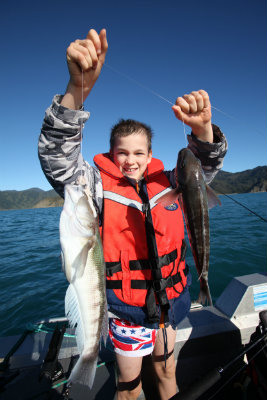 |
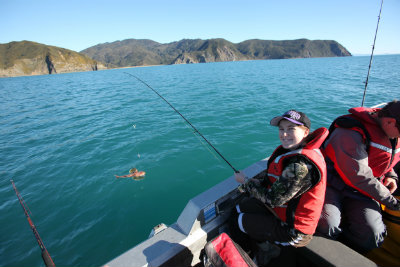 |
| Blue Heaven: Sam Mullon catches a blue Cod in Croisilles Harbour. | Caught red-handed: Caitlin Mullon catches her first red gurnard in the Croisilles Harbour, Marlborough Sounds |
Tapping away on the computer keys, I'm tired, dehydrated, reeking of fish and still wearing my gumboots, but I feel great. Bright, sunny winter days like we have experienced in Nelson the past few days are just too good to waste by sitting around inside when you could be out fishing.
We certainly made the most of the weather, fishing everywhere from the golden sands of Marahau on the Western side of Tasman Bay to Croisilles Harbour, Delaware Bay and Wangamoa Heads. Best of all we had a great time and caught beautiful fish.
It's a shame many boaties and fishermen stash their rods away during winter, because Tasman Bay and the Marlborough Sounds are year-round fisheries which provide sport, food and enjoyment throughout the year.
Sure, many fish, such as snapper and kingfish, head out deep to their winter haunts, but they are still catchable, and other fish that stay behind in close will most probably be your alone to enjoy, while other fishermen hunker down at home during winter.
Winter fishing can be a brass-monkey adventure if you let it, but by choosing the right days and times, it can also be very pleasant. For a start, there can be some glorious sea conditions, with flat, oily-calm seas and no afternoon sea breeze to contend with. That combines to make fishing a joy.
Temperatures are a little cooler, but with modern outdoor equipment there's no reason ever to get cold. In less than ideal conditions, waterproof rain gear, thermal clothing and even breathable Gore-tex waders are often part of our fishing kit when fishing from my 4-meter boat, but on idyllic winter days, you can be out there fishing in short pants and shirt sleeves if you want to.
Winter days are shorter, meaning there is usually less fishing opportunity in a day because darkness come early and stays late. Lately we've been fishing gentlemen's hours leaving home well after daylight when the rising sun warms our bones, with a nice drive, some boating, a few hours fishing over the warm sunny hours, and the boat back on the trailer in the golden afternoon light before driving home in the darkness.
One of my favourite fishing places within day-trip range is the gateway of Okiwi Bay, the entrance point to Croisilles Harbour. Not much more than an hour and a half from Richmond, the boat ramp at Okiwi opens up a Pandora's box of fishing opportunities for all types of boats, fish species , and fishing techniques.
Over the years we have had some awesome fishing adventures from Okiwi, watching the settlement of baches and houses grow in size and the number of trucks, trailers and boats increase.
The fishing is still good, though, in Croisilles Harbour itself, as well as the outlying areas of D'Urville Island and Current Basin. Discovered by French marine explorer Dumont D'Urville on his ship the Astrolabe in 1827, the charting of Croisilles Harbour, D'Urville Island, and French Pass (Te Aumiti) were significant contributions to the discovery and development of New Zealand's coastline.
Croisilles Harbour itself is a big area of largely sheltered water although it is subject to ocean swells and can cut up rough in times of bad weather.
The main geographic features are the bays of Whangare and Okiwi, with another large shallow cove extending eastwards called Squally Cove.
Squally ends in two large bays called Wairangi and Whakitenga and is the site of a significant number of marine farms, with new ones consented recently by the Marlborough District Council.
At the seaward entrance of Croisilles Harbour are the most prominent icons of the area. The three main islands of Moukirkiri, Motuanauru, and Otuhaereroa dominate the scenery with their statuesque beauty, although there are all-round panoramic 360-degree views of tall bush clad peaks and forestry operations on the land surrounding the harbour.
Fin-fish species abound, and there are also crayfish for those with pots or diving.
Croisilles Harbour is one of the last bastions of the Tasman Bay scallop fishery too, and they can be dredged for between August and February inclusive. There are even a few tasty dredge oysters out there as well.
This past week I've enjoyed beautiful sunrises, vivid skies and impressive air pollution from my kitchen window as I lit the fire for the family before they got out of bed, and while I supped on strong coffee.
With family here from Melbourne staying and 17 people in the house, it was cosy, but we had a great time together as families always do.
With nine Mullon children and four Mirfin kids, it is always noisy, but the cousins have a great time together and we even managed to do some fishing.
Brother-in-law Guy Mullon was keen to fish and take some of his children along to have a kiwi fishing experience while the Mirfin children were at school.
It was great to fish with my Aussie nieces and nephews and I'm sure we all got a lot out of the experience.
We had the waters to ourselves, with nary a boat in sight, and we caught red gurnard, blue cod, kahawai, tarakihi, flounder, snapper, barracouta and large numbers of the dreaded spiky dogfish.
Niece Harriet proudly told her cousins she had caught 19 "sharks" herself for the day. Nephew Caleb described his day as "good" although he spent much of the afternoon throwing up over the side despite the calm conditions.
Caleb has autism and views the world through different eyes, but caught lots of fish and especially enjoyed the legendary ice-cream selection at the Hira Store as we headed for home.
Likewise Sam and Caitlin were a pleasure to take fishing, lapping up the fishing, and enjoying the bait and jig fishing from the centre of a placid Croisilles Harbour.
Our last day provided good catches, and we finished in a flurry of action.
"one last cast" Guy said, as I tried to take his rod away so we could head for home. After three turns of the reel handle, Guy's rod bent double with the pull of a strong gurnard. "What a finish," he grunted with satisfaction.
Saltwater Fly Fishing, Nelson, New Zealand
Zane Mirfin, Wildside Column, Fish snap up flies in the briny, Nelson Mail, 29 June 2013
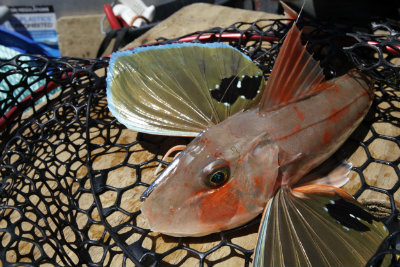 |
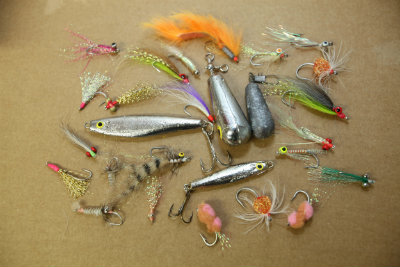 |
| Tie one on: Saltwater fishing without bait using jigs and flies is a recipe for success, if you know what you're doing. this red gurnard was caught on a homemade lead jig. | Homebaked: Roll your own flies, jigs and sinkers for saltwater fishing. |
I've always made many of my own flies, lures, jigs, and sinkers - ever since I was a young lad. I can still remember being besotted with the fly-tying set and instructional books my parents bought me at 9 years of age. For hours on end, I'd sit at the kitchen table, practising tying techniques and cranking out flies, lovingly laying my creations out on the table to admire and fantasise about big fish I would one day catch with them.
And I did. My first trout on a fly rod was caught fishing the fast waters beneath the Bulford Bridge on Marlborough's Rai River when I was just 10 years old. The spotted brown trout was no monster, but beautiful just the same to my youthful eyes. Having both parents witness my achievement, and catching it on my home-tied pheasant tail nymph made of red copper wire only enhanced the beginning of a personal fly fishing journey that is still ongoing.
Fast forward to the future, and my flies would appear in calendars, international magazines and fishing books. One New Zealand company, Manic Tackle, even has some of my dry fly and nymph patterns tied in some overseas sweatshop and shipped back for sale in Australasia.
I still love fly tying and Aimee calls it my "escape" where I can disappear into another world while creating solutions to angling problems. I have a permanently set-up bench in my garage with a lifetime of fly tying supplies accumulated with schoolboy pocket money and nearly 28 years of commercial fishing guiding behind me.
Many of the materials were harvested myself, shot with a boyhood air rifle, and later shotgun and rifle, or synthetic materials bought back from overseas guiding trips. I'm still accumulating materials and regularly tie flies so I can have the exact size, weight, colour, shape and style, to be consistently successful when guiding anglers from all over the world.
The past few years I've been fishing flies more often in saltwater. Durable synthetic materials and small mega-strong hooks have revolutionised salt water fly tying, allowing anglers to tie amazingly realistic flies that discerning saltwater fish are very partial to. In freshwater fishing, this is known as "match the hatch" where you use trout flies that imitate the insects that the trout are selectively feeding on and it's really no different in the salt. Give the fish what they want to see, at the right depth and with the right action, and success should be inevitable.
Saltwater fish feed on many items including fish larvae, shellfish, molluscs such as snails and mussels, minnows, marine worms, even crustaceans such as crabs, shrimps, crayfish, and krill.
Every fish species is different, and has a unique place in the food chain. By understanding the habits and food sources of fish you can become a more successful angler by offering fish something that resembles more closely what they prefer to eat. Flies can be hyper realistic or flashy but the key consideration in my mind is size. Most anglers fish with bait and hooks that are too big for the fish to get their mouths around.
I'm a great believer in going smaller and lighter when fishing. We use lightweight soft bait sets that can cast a long way from the boat, with sensitive, fast-action rods that can feel every bite and have the power to set hooks fast. Braided GSP line is another modern essential that has no stretch and offers incredible bite detection. Braided line comes in many bright colours so you can watch the line move and detect fish taking bait, flies and jigs. A fluorocarbon leader one to three times the length of the rod is attached with a bimini twist, kaneit knot, or other attachment system before the terminal tackle is tied on.
Because most fish are down near the bottom, a "drop-shot" or ledger-type rig is best with a sinker attached to the bottom and flies/hooks attached via droppers. Droppers can either be tied directly into the line using blood knots or even using three-way swivels, depending on the species you are targeting. You can catch all sorts of fish like this, either drifting or at anchor, but common Tasman Bay catches include snapper, kahawai, trevally, blue cod, tarakihi and gurnard. Often you catch other common reef fish like scarlet wrasse (parrot fish) and even leatherjackets (creamfish).
We often do away with a sinker and use a homemade jig as weight to get the rig to the bottom. Sometimes it will catch the best fish of the day or the flash will act as a fish magnet to your flies. With these rigs you can fish with or without bait, the choice is yours. Fishing with flies is nothing new, and basic commercial "flasher rigs" have been available for years and work extremely well but more imitative flies on longer shank chemically sharpened fly hooks work well for us.
You can put bait on the flies, with thin slivers of squid being especially successful, giving some more movement and scent. Bait isn't essential, though, especially if the flies are moving and are tied with materials such as flashabou, krystal flash, silicon rubber legs, marabou, spanflex, neve fibre, rabbit fur, or bucktail.
Fly tying is actually pretty easy to learn and you can set yourself up with a vice, tools, threads, materials, and hooks and be tying workable flies within an hour or two. My four kids love going down to my desk and tying flies on their own. Some of their efforts are pretty rudimentary but the fish eat them up.
Fish are attracted by eyes, either painted or tied onto any lure or fly, and dumbbell eyes can really make a saltwater fly come to life. Flies tied with multiple colours of egg yarn to imitate chunks of berley work great too, and you never have an empty hook down there when the fish are in a feeding frenzy.
We also make our own lures, jigs and sinkers too by melting lead outside and pouring it into moulds.
Hey, I just got emailed a photo from my brother Scott Mirfin of a kingfish he caught on one of our homemade lures during the beautiful sunny winter weather we've been basking in. At about 35-40kg, it was the only big fish of the trip and was released unharmed.
Score one more for homemade gear.
Winter Beach Seining, Port Underwood, Marlborough
Zane Mirfin, Wildside Column, Going flat-out at the beach, Nelson Mail, 4 May 2013
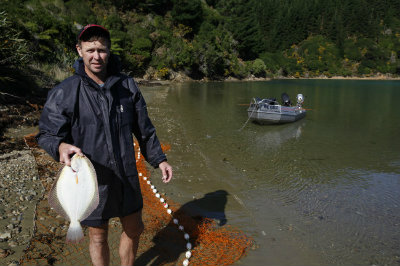
Bountiful shallows: Scott Mirfin with a Port Underwood flounder caught by beach seining.
It's hard to believe May has arrived and that winter is right around the corner. Trout fishing season may be over but duck shooting season brings a nice change of pace.
The April school holidays were a lot of fun again and although we didn't go anywhere too exciting this year we still managed to get away for some family fun, including a couple of coastal adventures.
In a new world of recession, economic doldrums and fiscal prudence, finding the time and resources to spend on extended holidays can be a real challenge. Fortunately, living in the top of the south there are plenty of nearby family adventures to be had that don't need to cost an arm or a leg to enjoy. Often too, you can combine a spot of fishing or hunting with other activities such as visiting relatives, after sports trips, or even while gathering firewood.
Port Underwood in Marlborough is a great place to visit, being a sheltered harbour which forms an extension to Marlborough's Cloudy Bay. With an exposed entrance to the Pacific Ocean and Cook Strait, you really have to pick your weather and sea conditions to experience it at its best and most bountiful.
Fortunately for Nelsonians, when the weather is foul with howling norwesters, whitecaps, and an un-navigable Tasman Bay, Port Underwood can be a fine place to go.
This year we stayed at the Rarangi Surf Club at Whites Bay with brother Scott and his family, which was a very cost-effective family option. The beach at Whites Bay was awesome and the kids had a blast running and playing along the beach.
It was great family fun and the six cousins had a whale of a time, both inside and out. We even did a spot of fishing with my beach seine net.
Beach seining is somewhat of a lost art these days, but well known by early Maori and British immigrants dating all the way back to Captain James Cook. It's a simple method where warp ropes are laid out by boat using oars and the 40-metre seine net is retrieved by two teams from shore.
As the net is hauled inshore it forms a large belly and the lead-weighted warp ropes stir up the silt and sand on the sea bottom herding the fish into the middle where they are scooped up by the incoming net. It doesn't always work as well as that, but can be a successful method to fish sandy beaches and deep channels.
My first memories of fishing this way were many years ago as a small boy with my grandparents at Rabbit Island beach, where we used to catch flounder by the sackful. The sea conditions at Whites Bay were superb one morning but by the time we'd had breakfast together and completed the tortuous drive over hills around to Ocean Bay where we could launch the boat, the swell had come up. We powered along the rugged coastline back to Whites Bay in my boat to meet the family who were all waiting ready to go on the beach.
It wasn't ideal, with moderate breakers rolling ashore, but the kids were keen to give it a go, so try we did. Two drags of the seine net and with only blue moki to show for our efforts convinced us that it was time to try somewhere else.
The breaking waves had soaked the kids and our wives so they retreated to the surf club to dry out while Scott and I took the boat further along Port Underwood to try for flounder in calmer waters.
The net was a big haul for two guys on our own but we tried another two drags in sheltered bays, catching a few flounder, large paddle-crabs, and some sunken logs. It wasn't a huge success but we'd had family fun and learnt some new places to fish.
Next time we visit Port Underwood we'll get the rods out to fish for red cod, blue cod and moki, and be certain to take some crayfish pots to set overnight.
My other favourite April school holiday outing was with son Jake. Gathering firewood has always been a Mirfin family pastime but during the past couple of years I always seem to be too busy to be as organised as I would like. It's almost embarrassing to admit that I've even had to buy some firewood this year but fortunately friend Steve Anderson invited us on an overnight trip to his remote coastal property.
"Bring your trailer," he said. "Lots of dry firewood around." It was a great opportunity to take my eldest boy Jake away for a night without the distractions of his younger siblings, with the chance of a goat, pig or possum for Jake to shoot at always being appealing.
We had a fun night away, with Steve being excellent company. It was a bonus collecting manuka, bluegum and pine firewood together but the real value of the trip was Jake getting to spend time in the company of males, doing fun things, and learning new skills.
Steve had Jake hooking up chains to drag manuka logs, splitting firewood, loading trailers, and many other important tasks. Coming down the hill with the trailer, Jake spotted golden fungi glowing in the soft afternoon light. I took a photo with pine forest in the background.
Later we went fossicking on the beach and before dark we went high looking for a wild pig for Jake to shoot. The wind was howling and we found no pigs but Jake has keen eyes and spotted a small mob of goats out in the open. Stalking closer, Jake got a few unsuccessful shots away at a black and tan billy-goat across a windswept gully before the goats bolted for cover.
It didn't matter, as Jake was having a great time out in the fresh air, marvelling at the vivid sunset that lit up the horizon between water and sky, and learning the lessons of life.
Later we cooked up a roast dinner in a wood-fired stove, told stories, solved the problems of the world, did dishes, and got ready for our next adventure - spotlighting for possums.
We covered a lot of distance but the wind was fierce with waving trees and dust everywhere. The possums were few and far between but Jake got a few shots with his single shot .22 and learnt a lot about the art of hunting after dark.
It was a tired boy who hit the pillow that night but we all enjoyed a big sleep in, waking to a beautiful day before heading to the beach again to pick up some of Jake's treasures from the day before. We even had a man-sized brunch of cold beef, fried spud, baked beans, scrambled eggs and gravy before Jake set up a target and had some more shooting practice.
Soon it was time to go. Reality and civilisation were calling, but as I looked at the growing blonde boy in the truck seat beside me, I felt pride at the sensible young man he was becoming. I realised then, that it wouldn't be too many years before our school holiday adventures together would only be a distant memory for us both.
I just hope he remembers the good times he had with his dad.
Flounder, Tasman Bay, Nelson
Zane Mirfin, Wildside Column, Life is great when it's a drag, Nelson Mail, 20 April 2013

Flat Out: American Angler Tim Vining rated dragging for flounder as a highlight of his New Zealand fishing.
In a complicated and out-of-control world, keeping things simple can be a great tonic for the soul. At this time of year I find myself looking forward to going floundering, where the fishing is simple, and you don't have to beat yourself up or put in too much effort to get a feed from local estuaries and beaches.
Here in the top of the south we are fortunate to have so much prime flatfish habitat so close to home with flounder and sole inhabiting the whole coastline in the section sandwiched between Marlborough and the West Coast.
The fish aren't there like the "good old days" but there are still plentiful flounder to be caught once you understand the habitat, tides, channels, sea conditions, seasons, and the behaviour of the fish themselves.
Flounder aren't a glamorous fish but they sure are tasty, either fried whole dipped in flour, or filleted. My kids love eating flounder which is a good thing because it gives us a regular excuse to escape and head out on short floundering expeditions close to home.
The last few years I've got really keen on set netting using my boat, or even night-time flounder spearing with hi-tech lighting systems. Both methods work well but lately I've enjoyed going back to my floundering roots taught to me by my father and grandfather where we hand-drag a net between two or more people as a team.
Drag netting for flounder is a time-honoured way to catch flounder and you can fish at any time of day and at any stage of the tide, depending on what you are trying to achieve. Drag nets are a basic affair, somewhere between 20 and 40 metres in length, with a weighted bottom rope and a top rope with floats attached.
Most drag nets are made with a durable synthetic mesh about 25 meshes high, with the most common mesh size designed for moki nets which is about 114mm. Mesh size isn't too critical though and you can also use virtually any nylon meshed nets over 100mm.
Lately I've pulled several of our old moki and butterfish nets out of retirement and customised them into flounder drag nets by adding more lead weight to the bottom rope using old sheet lead from chimney and roof flashings.
Flounder are adept at finding gaps in nets too and it's always a good idea to use net-making cord to plug any gaps in a loosely slung net. Many nets, even brand new commercial models, often have large gaps between where the mesh is attached to the ropes at top and bottom. By eliminating these gaps you will catch many more flounder. Length of net is another important consideration and in recent years we've enjoyed nets shorter than the legal maximum of 40 metres. Shorter nets around 20 metres are a joy to use for two people, being easy to drag, and useful in places along the edges of channels where a longer net would be too long and cumbersome. Other handy floundering tools are a knife to gut and gill your catch, as well as an old sack or a diver's catch-bag to store fish.
Each end of the net is attached to a manuka pole, top and bottom, and one or more people at each end drag the net between them allowing a curve to develop which traps the flounder in the belly of the net. Flounder normally aren't gilled in the net but are carried along in the net belly as the net draggers cover a strip of water somewhere between ankle-deep and neck-deep.
The length of drag can be anywhere between a few metres and several hundred metres, depending on circumstances, and the fishers keep the net moving as the deep-end crew swing around into the shallows and the net is hauled up on the sloping beach.
It's great fun checking out what is in the net after each drag and always exciting to see flapping flounder trapped in the net. Often no fish are caught, only weed, shells, pacific oysters, paddle crabs, sticks, jellyfish, and urban rubbish, but sometimes you hit the jackpot and catch many fish with minimal effort.
There are a few tricks of the trade and I always look for still conditions, with clear water and no weed piles stacked up on the high tide mark. Nelson beaches also fish best in southerly conditions as the sea is flat with minimal weed. You can drag channels or main beaches, but you need to avoid strong currents which will make it near impossible to drag the net.
Most of the time we wade wet with old sneakers on our feet although at this time of year we're increasingly wearing Gore-Tex or neoprene full body waders to stay fully dry. There's always a risk of stepping into a deep hole so we always wear a lifejacket when wearing waders or dragging after dark to add a margin of safety to the exercise. There are a few beasties in the ocean, too, and I've often marvelled at the numbers of large eagle rays visible in the water from flying above. Sometimes we've even seen big sharks near the surface, not far offshore from the beach. It's a fact of life that you'll catch a few eagle rays in your net while dragging, so be careful extracting them before release as they have a razor-sharp spike on their tail.
We've never had an issue stepping on a ray but you'll step on plenty of paddle crabs, hence the solid footwear. Crabs are an occupational hazard of floundering but are easily removed from the net by hitting them a few times with a solid stick from the opposite side of the net from which they were caught.
Drag netting has a lot to recommend it, with a team atmosphere and minimal gear required. It's an active fishing method which means it's never boring and there's always something happening.
Best of all it's legal to use drag nets in areas banned to set netting which opens up a lot of opportunities especially on the eastern coast of the South Island which has a set net ban along the coast.
I even use my boat to access some great locations that are more difficult to reach by foot. Using the boat for access and dragging on foot is the best of both worlds because you can change locations and hunt the fish on rising and falling tides.
Some of my overseas anglers have loved dragging a net to catch a few flatties at the end of a rod fishing day. American client Tim Vining rated a couple of drags of the net and catching a few flounder at day's end as one of the highlights.
My kids love the beaches and channels too and in our last drag netting effort, last week, brother Scott and I dragged the net, while our six kids played alongside, splashing in the water, catching crabs, and even a seahorse. It didn't take long to catch enough flounder for a good feed, and the kids revelled in the wild, open spaces and warm afternoon sun.
A visit to the local store for icecream made for a great afternoon together - the stuff family memories are made of.
Fly Fishing the Motueka River, Nelson
Zane Mirfin, Wildside Column, Motueka: a river in peril, Nelson Mail, 6 April 2013
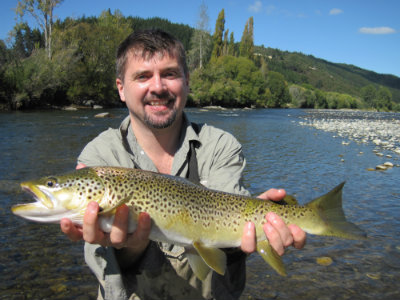
How now brown trout: Christian Wurzinger of Austria enjoys success on the Motueka river.
Late-season fishing is my favourite time of year to fish for trout. For a start, the days are shorter and it's cooler and more pleasant to be outside.
Rivers also tend to be low and more accessible, concentrating the fish in catchable locations where they hungrily feed in preparation for spawning and the hard winter months ahead.
There can also be some great late-season mayfly hatches where mayfly duns pour off the water some afternoons, making for excellent dry-fly fishing to rising trout dimpling the surface of favourite pools.
The fish themselves are in the best shape of the season, heavy of body, and beautifully coloured with bright yellow and orange flanks as they approach spawning season, safe from anglers after April 30. They're also more aggressive than usual, losing their timid nature as they start to think more about sex than eating. But maybe the major reason I like late-season fishing is that you generally have the rivers all to yourself as other anglers hang up their rods for another season and stay home.
It's a special experience being out on the water late season and not following others bootprints, but there are challenges too. The days are short and with the sun being low in the sky it can be difficult to sight fish except during a few hours over the middle of the day.
Fishing the water blind or with exploratory casts is almost always part of a successful strategy and it's very therapeutic too, to hear the fly line whizzing through the air, watching the water spray off the backlit line, and feel the satisfying pull of a solid trout.
Once daylight saving finishes, the days really get short, and a fishing day consists of leaving before daylight, fishing till dark, and driving home in the inky blackness. Because I'm so busy over spring and summer, autumn is one of the few times I get to dust off my fly rod and fish by myself.
Lowland rivers are especially good late-season, being close to major population centres. Using small dry flies and nymph imitations on light line is great fun, in riffles, pools and runs. Fish will tuck in against the shore too, under vegetation, and near big rocks and structure, offering exciting fishing to quality trout in shallow water.
In the Nelson region we are fortunate to have the Motueka River nearby. The Motueka is one of New Zealand's best fisheries, recognised as a nationally important angling water, and also protected by a Water Conservation Order. The key to angling success on the Motueka is to pick fine anti-cyclonic conditions, with a good moonphase, and low river flows. Use small flies in the No 16-18 size range with 5x fluorocarbon tippets on long leaders and success should be inevitable.
With great public access, easily waded pools, and good trout numbers, the Motueka River below the Wangapeka confluence to the sea is the most heavily fished piece of water in the Nelson Marlborough Fish & Game District. It's not all great news, though, as the Motueka continues to decline as a fishery for a variety of reasons, most of them induced by the effects of man on the environment.Trout are just a barometer of habitat and water quality, and the river is no longer the fishery it was when I first started fishing there almost four decades ago.I have some great memories of the Motueka over the years but perhaps some of my most vivid are meeting my boyhood hero, Norman Marsh, author of Trout Stream Insects of New Zealand - How to Imitate and Use Them, when we both presented information to the tribunal panel hearing the Water Conservation Order applications back in 1990.
I'd just finished my masters thesis at the University of Canterbury entitled "Trout Fishing in Nelson - Management of a Recreational Resource" and was an over-confident young man full of piss and vinegar. Norman was an elder statesman of the sport, a gentleman and a philosopher, and we enjoyed each other's company both on and off the stream.
Norman is gone now, and unfortunately so are most of the trout.
We've had some good fishing days lately in the Motueka, but it ain't what it used to be. My results are still very good, but it must be hard fishing now for less experienced anglers. The wading was difficult on nitrate encrusted rocks, the shallows were full of sediment, and stock wandered at will to stand in the water.
On the banks, houses were being built and the classic Motueka river corridor was being degraded by development, while adjacent land uses such as exotic forestry plantations were highly visible on the sensitive Separation Point granite soils.
It's just such a shame. The Motueka is a world-class fishery, just slipping into potential oblivion due to the lack of a decent management plan and some love and attention. Some will not agree, but without action the Motueka River ecology will continue to implode.
There has been a noticeable change of the insect biomass within the river in recent years, with mayflies, which require clean water, being replaced by more pollution-tolerant caddisfly populations.
Fortunately, the water quality is still OK because much of the water comes out of protected conservation land, but it's what happens between the DOC estate and the sea which is critical. With a few simple steps, it could be protected and enhanced.
The Motueka is one of the most studied river systems in New Zealand. The issues and problems are well understood, but it's time to act before it is too late for the river and for Tasman Bay. The Motueka plume is a major contributor to the fertility of Tasman Bay and we humans monkey with nature at our peril. The scallop fishery has collapsed, largely because of excessive sedimentation, and last year's floods impacted on the inshore snapper fishery. What's next?
Recent proposed central government reforms to streamline and speed up Resource Management Act (RMA) processes are also ringing alarm bells around the country with Fish & Game's Neil Deans charitably describing proposed changes as "giving the chookhouse keys to the fox".
My view is that if you need any evidence of why it would be a bad idea to allow politically expedient decisions about water quality and quantity to be made by regional councils around the country you need only look at the current pitiful state of our lowland waterways. Water management in this country is in a crisis and desperately crying out for some leadership.
The Land and Water Forum was a good collaborative start but the 150 recommendations are a total package that central government shouldn't be allowed to cherry-pick to suit its own agenda. The big corporates like Fonterra would be better served by not giving away free icecreams at local government conferences and actually doing something worthwhile and meaningful about water quality issues.
Our waterways are under increasing attack from all angles, rural and urban, and I don't blame farmers who are only trying to make a living. But I do blame central government, local government, and even local communities for failing to act in the face of overwhelming evidence of what is happening to our waterways nationwide.
Arguably I know as much about the fisheries of the northern South Island as any other individual after a lifetime of learning and commercial exploration. I cannot think of a single freshwater fishery that has improved over time.
Recently, during a Motueka River lunch-break with Christian Wurzinger of Austria, we ate albacore tuna sashimi and fried tuna steaks beside the gurgling river. Christian was on his sixth fishing trip to Nelson with me since 1998, and has taken his financial skills and business acumen around the world.
While we ate and talked, he marvelled at a Nelson Mail article featuring the proposed RMA reforms. Calling it "China Syndrome", Christian shook his head with disbelief at the Government's ill-founded model which encourages exploitation of natural resources and the environment for short term economic gain. "Without the environment and rivers, New Zealand is nothing," he told me.
Fly Fishing in the Heat of Summer
Zane Mirfin, Wildside Column, When trout play hard to get, 23 March 2013,Nelson Mail,
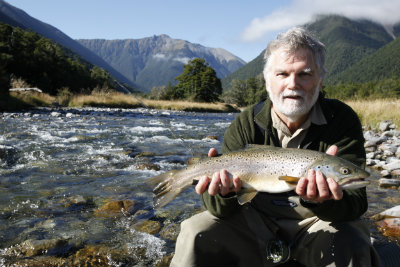
Where there's a will: Tim Hammond with a typical local summer brown trout.
At this time of year, trout fishers need to fish early or late in the day, seeking cooler rivers where trout will often congregate to escape the warm summer waters.
Summer is finally upon us with those balmy sunny days. With the sun comes the blistering heat, drought conditions and low river flows of late summer.
Driving around the district lately, it's apparent that things are getting pretty dry out there with pasture dying off, the ribs sticking out of rivers, and irrigation systems working overtime. It's no different elsewhere in the top of the south on our fishing travels lately with parched conditions and rivers throughout Marlborough, West Coast and North Canterbury also very low.
It's been difficult sleeping too with hot muggy nights, and even the kids are grumpy. The heat out on the river has been intense as the radiation beats down in Melanoma City.
I've always called it the summer doldrums when the trout lay low, becoming inactive and lethargic. Humans behave much the same way and interestingly, international sharemarkets historically suffer the same fate over hot summer weather periods when investors lose interest and would rather be at the beach with their family.
The early Greeks, including Aristotle, termed the summer heat the "dog days of summer" as they associated the hot northern hemisphere weather with the rise of the dog star Sirius.
Ancient Romans routinely sacrificed a brown dog at the beginning of the dog days to appease the rage of Sirius, believing that the star was the cause of the hot sultry weather.
Such dog days were popularly believed to be an evil time when "the sea boiled, the wine turned sour, dogs grew mad and all other creatures became languid; causing to man, among other diseases, burning fevers and hysterics". Thankfully it doesn't get that bad here but the dog days of summer do exist for a few weeks each year so we may as well enjoy them before the cold of winter arrives.
It's ironic that peak tourist season in February coincides with some of the toughest environmental conditions of the year as overseas anglers escape the cold and dark of the northern hemisphere winter to the hot, dry, summer conditions of New Zealand.
It's no secret that the local tourism industry has been battling tough economic headwinds lately, with a high New Zealand dollar and worldwide economic recession caning many local businesses. Sometimes it can seem like a perfect storm of economic and environmental conditions conspiring against small business but I've just been thankful that the phone keeps on ringing.
After close to three decades prowling the waters of the South Island as a fishing guide, I've come to learn the cycles of nature and man and grit my teeth throughout February and just concentrate on getting the job done.
My favourite times to trout fish have always been early and late season when river flows are higher, waters cooler, and fish more active. Catch rates can drop off in January and February as trout become wary to the ways of man and are more challenging fish to catch.
The anglers too are often different outside summer with the best often knowing to avoid the peak summer months with crowded rivers, swimmers, holidaymakers and less co-operative trout. Perhaps the best fishing opportunities available locally at the moment are in the saltwater scene as snapper move inshore and yellowtail kingfish and albacore tuna thrive in the warm tidal waters.
But the trout are still there and can still be caught. Probably the major issue at this time of year can be the low river flows and high water temperatures.
Theoretically, it should be easier to catch trout in low flows because the fish are more concentrated but it doesn't always work out like that. Soaring water temperatures can see trout disappear and vacate previously good water as they shun the hot sun and warm water.
Many local lowland rivers routinely go over 20 degrees Celsius in the hot conditions into what I call the "death zone" and any good angler will carry a digital meatworker's thermometer in their fishing vest to regularly test the water temperature.
I have caught trout at close to 23C but such fish are likely to have trouble recovering from capture in the boiling waters. I've even seen fish die in such warm waters and experienced anglers will stop fishing long before the "death zone" is reached.
Even the normally ice-cold rivers of the Nelson Lakes region are approaching 17-18C by the end of hot days lately.
Trout are a cold water fish and feed best between about 10C and 18C, meaning that mornings are the best time to fish at this time of year. Lately we've been starting early to get much of our fishing done before lunchtime and before the oppressive afternoon heat shuts the fish down.
Strategies for this time of year include fishing early and late in the day, fishing cooler rivers, or seeking out the confluences of cooler spring-fed streams where trout will often congregate. Trout will move into faster water, too, seeking water with a higher oxygen content. Fast, shallow runs often see trout stack up in search of food and oxygen, making for some exciting sight fishing.
Summer fly fishing is all about treading quietly, casting well and using small flies and light line to fool educated trout. It's a lot of fun, and there can even be some great dry fly fishing on the larger lowland rivers with trout gently sipping spent mayflies off the surface from evening spinner falls the night before. Sometimes you can look up a pool and see literally dozens of trout slurping spent spinners off the surface, their small black heads pock-marking the water's surface.
Summertime is also terrestrial time where you can fish artificial beetles that are brown, black or green, flying ants, and all other manner of land-based creepy crawlies. Some of my favourite terrestrial "hatches" to fish are the willow grub slurpers that sit up under the surface locked in on the diminutive little yellow grubs that fall into the water under willow trees.
Such trout can be very selective and frustrating to catch but it's exciting close-range fishing for trout that are hyper-visible and very active.
Other local bugs that are fun to imitate are the passion vine hoppers that appear every year about this time on lowland waters. This small delta-winged insect is hungrily sought after by trout and they'll take these bugs in a distinctive head and tail rise. It's "match the hatch"-type fishing but flyfishing at its best as trout selectively feed all around you, often oblivious to your offerings.
Perhaps the ultimate terrestrial fishing is cicada time where back country fish go wild on big clumsy bugs splatting down on the surface. Falling rivers after rain can turn on some spectacular cicada fishing as big trout lose all caution and go on a feeding frenzy.
The best cicada imitations are tied out of flared and spun deerhair, clipped to shape with bulky synthetic wings and even dumbbell plastic eyes to look just like the real thing.
Summer trout fishing isn't always easy. Lately we're caught our share of fish but also had days when we worked hard to catch trout too. Some rivers appear to have very light numbers of trout as climate change kicks in and the large floods over recent years have literally ripped rivers apart.
The rivers of Murchison and Reefton have taken a real pasting and sometimes I wonder if New Zealand trout fishing had a magic century of angling from the 1880s before the 21st century came about.
The trout will always be here for us to enjoy, although you might have to travel a little further, and maybe have more realistic expectations.
Albacore Tuna, Tasman Bay, Nelson
Zane Mirfin, Wildside column, Out at sea in a joyful pursuit of tuna, Nelson Mail, 9 March 2013
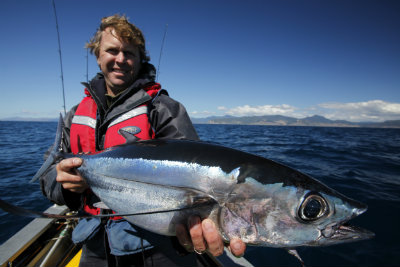
Princely albert: Scott Mirfin with an albacore tuna caught in Tasman Bay.
With the brilliant sea conditions out in Tasman Bay lately, it's been driving me crazy having to go trout fishing every day.
It hasn't helped knowing that the bay is full of albacore tuna that are whacking trolled surface lures with abandon for those out there fishing. Yep, tuna fever has finally hit Nelson and every man and his dog is out there chasing them in a tuna frenzy.
Shops have been doing a roaring trade selling trolling lures for the pelagic game fish known as "chicken of the sea" due to their cooked white flesh and fine eating qualities. Albacore tuna (Thunnus alalunga) are found all over the world in the open waters of all tropical and temperate oceans, even the Mediterranean Sea, with lengths up to 140cm and weights up to 60kg. Around these parts they're usually much smaller with a 10kg tuna considered a pretty good fish.
Tuna are a great fish to eat and albacore (often nicknamed "alberts") are considered a "best choice" tuna species although concern has been expressed with overfishing in the Indian Ocean and North Atlantic albacore fisheries.
Luckily for us, Pacific stocks of albacore are seen as some of the most prolific in the world although in 2010 Greenpeace International added the albacore tuna to its "seafood red list" of fish that are commonly sold in supermarkets around the world and which have a very high risk of being sourced from unsustainable fisheries.
Interestingly, albacore can have a high mercury level in their flesh due to them being highly placed at the top of the food chain, accumulating methyl-mercury in body tissues over time.
Most of us here in the Nelson region would have real trouble overdosing on tuna steaks but the US Food and Drug Administration advises women of child-bearing age, and children, to limit consumption to 170g per week or less.
Albacore tuna, apart from being a great sporting fish to catch on a rod, are also magical looking. Tuna are a fish of beauty and built for speed, with big eyes, slimline jaw, shining sides, tubby body, sickle-shaped tail and elongated pectoral fins which can be as long as half a body length.
Whoever designed the tuna did a masterful job, even creating special grooves in the side of the body for the pectoral fins to tuck into for hydro-dynamic efficiency when swimming at speed.
Tuna can be caught many ways but trolling is the preferred method using lures with single, double or treble hooks.
Tuna are routinely lost as hooks pull out, especially at the boat, and for this reason it's usually best to net albacore at the boat rather than trying to gaff them. Alberts are an interesting fish to cut up, being the ultimate tubster, built like a proverbial brick outhouse, and fair bursting out of their skins.
"Neither fish nor fowl" seems an apt description of tuna as they are warm inside to gut, and when filleting it feels more like butchering a sheep. They don't even smell like a fish. Albacore have a central bone ridge through the flanks which means that most fish end up as four separate loins in the ice chest. Preferred lures fall into two main categories, either a tuna skirt lure with metal/plastic head, complete with eyes and silicone rubber skirt to look something like a squid, or a bibbed diving "rapala" style lure that imitates a small baitfish. The key is to get your lure in the face of a hungry tuna at the level that they are swimming.
What our local tuna lack in size they make up for in fight, ripping line off the reel in crazed adrenaline-inducing runs when near the boat, and staying deep under the boat with a tough grudging fight as you pump them upwards toward the waiting net.
Most anglers use heavy trace, commonly up to 200lb to make lure loss less likely when the dreaded "Cook Strait Sailfish" or barracouta turn up. Barracouta are a real curse, biting through traces and taking those expensive lures that can be more than $50 each.
Many people also troll lures at a fast clip to try to minimise the barracouta bycatch, and who knows, you might even get lucky and nail a big yellowtail kingfish. Recommended trolling speeds are 6-8 knots but many anglers are being successful at considerably faster speeds.
There's no magic secret for finding tuna, as they like it out in the deep blue water, and preferably near current. I guess tuna have always come into Tasman Bay but over the past few seasons recreational anglers have been targeting them more regularly and the tuna appear to be here in bigger numbers for longer periods.
Tuna are warm-water nomads that hunt the rich ocean currents in pursuit of their prey and as the earth heats up and the ocean currents warm and change we will probably see more tuna frequenting our local waters. Tuna aren't the only fish to follow the warm water, and believe it or not, a marlin was allegedly seen off Farewell Spit recently.
I'm sure many more oddball fish will follow in the years ahead given the comments of one of my recent Australian fly anglers who lives in Cairns, Australia. Over there, Simon explained, anglers are catching all types of tropical fish turning up in places that they never used to be, due to warming oceans and current changes. Temperatures can be predicted by satellite now and keen Aussie anglers even go to pay-per-view websites to track daily current flows and GPS co-ordinates which is where the fish will be.
Out at sea in pursuit of tuna is a wonderful experience, with oily blue water and marine wildlife in abundance. Dolphins and penguins are routinely encountered and specially adapted sea birds abound. Gannets, shearwaters, petrels and even the giant mollymawk are beautiful birds living wild and free, gliding high over the deep blue sea.
Sometimes you'll even see shark fins breaking the surface, as they prowl their ocean domain. On a perfect fishing day, you may see boil-ups of savage fish feeding, wheeling birds diving into the melee, and we've even seen tuna jumping clear of the water with their sickle-shaped tail fins silhouetted against the back-lit horizon as they chase fleeing prey.
Out in Tasman Bay yesterday with my brother Scott was a special experience. The forecast light easterlies became savage easterly winds that turned the water into a wind-whipped sea of whitecaps. We tried trolling, getting wet, and without success we sought shelter inshore. But by afternoon the sea flattened and idyllic conditions made life at sea a joy.
We caught heaps of barracouta and had a ball reefing in copious numbers of big kahawai that boiled the water all around the boat at one stage, but the alberts were elusive. Back trolling, I rang Aimee to tell her we were on our way home - with no tuna. Then it happened, Scott's rod bucked as a heavy fish bent it.
Pumping the fish from the depths, the tuna came into sight with shimmering sides and pearlescent shades of loveliness as it fought, splashed and surged beside the boat. Soon it was in the boat, and it was high fives all round, before Scott buried a big treble hook into his finger while still attached to the tuna.
Pushing the hook through his finger and squashing the barb we managed to get the lure free and back in the water trolling again. Almost immediately we had two more fish on, one apiece.
The tuna dived for the depths, our lines crossed and tangled, but we managed to get the two fish into the net after nerve-racking moments.What a great finish to a great day out. End result - two men hopelessly addicted to tuna.
Snapper Fishing at Mapua, Nelson
Zane Mirfin, Wildside Column, Drawn to the seaside charms of Mapua, Nelson Mail, 9 February 2013
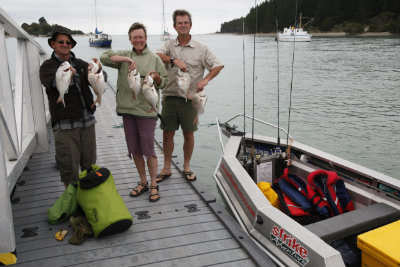
Dropping a line: Danny Hajdu, of town & country Veterinarians, and Jo and Tim Leyland, of Tapawera, hold some representative "pannie" snapper they caught at Mapua this month.
Mapua Wharf is a rather special place. With coastal vistas, surging currents, salt air, summer sun and brightly coloured seagulls it is a very accessible coastal jewel.
As a kid I always loved fishing off the wharf for spotties and sprats and lately with summer crowds and hot weather kicking in, it's been a great place to hang out and enjoy yet again.
First known as the "Western Entrance" by early settlers, the Mapua Channel is the western gateway to the ecologically significant Waimea Inlet. Important to early Maori, archaeological evidence showed significant usage around modern day Grossi Point.
Interestingly, the ravages of North Island Maori armed with muskets and led by warrior chieftain Te Rauparaha meant early European settlers encountered relatively few local Maori when they arrived. The first land in Mapua was reputedly bought in 1854 by Captain James Cross, an early maritime pioneer of the western entrance, and cost just £60 for a generous 166 acres.
There are some well-crafted interpretative display boards on the Mapua Wharf that outline the history of the wharf. It was first operating about the 1870s as a simple jetty to facilitate the transport of flax bales and manuka stakes harvested around the edges of the estuary.
Soon, the flax industry was eclipsed by the burgeoning apple industry and the wharf expanded and was commercially operative until about 1965, after which modern roading systems and trucking resulted in the economic demise of the wharf. Allegedly the wharf was almost demolished in the 1980s but lobbying by the Mapua Boat Club led to the redevelopment as it exists today.
The Mapua Boat Club, of which I'm a proud member, is a great local organisation with some lively characters headed by President Annette Walker. Annette always reminds me that "we're long-lost cuzzies", sharing a common ancestor. Captain John Walker was my great-great-grandfather and by all accounts a very capable man at sea.
At the family St Arnaud Lakehouse hangs an old black and white image of Walker's cutter The Supply, a sailing ship of 26 tonnes that he successfully sailed from Nelson and through the Buller River Bar, near modern-day Westport. Delivering explorers and surveyors John and James Rochfort ashore in September 1859, they went on to discover the rich coal seams of the Denniston Plateau.
Walker was also a pioneering mariner within Tasman Bay, including Mapua. At the Boat Club Museum on the wharf there are many old photos of the paddle steamer Lady Barkly built in 1868, being 43 tons, 91ft long and of wooden construction.t, "Over a period of 57 years, some 20 captains sailed in command of the ‘Barkly'. Captain John Walker was the first master."Another clipping said: "So appeared the Lady Barkly when in 1868, under the command of Captain John Walker, she made her maiden trip in the Blind Bay trade with which she was to be long and favourably associated."
Walker regularly operated from Nelson, along the western shores of Tasman Bay, including Mapua, to Tarakohe, Waitapu, and Collingwood in Golden Bay. Items of Captain Walker's sailing equipment, even his pistol, are on permanent display at the Nelson Provincial Museum. It's an emotional moment every time I look into that glass cabinet and feel a jolt of pride at having a genetic link to a small slice of Nelson history.
Perhaps the darkest mark against the Mapua Wharf area is its history as one of New Zealand's most contaminated sites because of agricultural pesticide residues in the soils from a defunct factory.
Between 1932 and 1988 a cocktail of chemicals was used to produce orchard pesticides such as DDT, dieldrin, 2,4-D, and paraquat. Fortunately measures were later successfully taken to prevent the leaching of chemicals into the adjoining Waimea Estuary by local government and the Ministry for the Environment. Nowadays the remediated site has been developed as the Mapua Waterfront Park for the visiting public to enjoy.
Mapua is a great place to go snapper fishing too. Out into Tasman Bay by boat, the world is your oyster with plenty of snapper, kahawai, gurnard, flounder, paddle-crab and rig for everyone.
On our last trip out fishing we enjoyed modest snapper success but people must have been impressed watching my guests carrying their catch off the wharf. Someone at the Jellyfish Cafe even asked me if I was "the snapper man". Snapper come into the estuary too, and one angler I talked with had managed a few "pannies" fishing off the wharf itself in recent days.
The Mapua Bar can be a treacherous place and always demands care when entering or exiting the Mapua Channel. Access is weather and tide dependent, with big tidal variations and strong currents running.
The "bar" can cut up rough at any time but the worst time is during a strong northerly wind and swell, with a strong outgoing tide which can produce big standing waves that can make navigation exciting, to say the least. Be especially careful near low tide, as the bar can be very shallow.
The new channel markers give a good guide to the channel but they aren't perfect and recently I hit rocks on the edge of the channel, fortunately at low speed, taking a couple of chunks out of my aluminium propeller.
Back home, I managed to file the prop edges back square with a metal file but it reminded me of the time I was fishing the world famous grayling river Idjsostrommen in the mid-1990s with my Swedish friend Leif Milling. Leif was gunning his Rolls-Royce through a field of long grass en route to the river when we hit an immovable rock which stopped the car dead in its tracks. A sombre-faced Leif turned to me and said: "I have not met that rock before."
Across the channel from the new floating wharf pontoons is Rabbit Island. Motoroa or Rabbit Island is the largest of a group of sandy islands lying in the Waimea Estuary, and along the seaward side there is more than 8km of safe sandy swimming beach.
You can drive to the region's largest picnic area, but accessing the island via the Mapua Ferry is an exciting new option. The tidal channels around the islands between Mapua and Monaco are also a lot of fun to explore. Many people now enjoy riding their bikes between the two coastal settlements but I especially enjoy doing the Waimea Crossing in my boat.
The Mapua area has developed into a flourishing settlement in its own right, with a vibrant commercial area around the wharf. Mapua continues to grow in popularity for summer visitors and is home to people from throughout the world.
Holiday locations like the Mapua Leisure Park have always been well known to Canterbury holidaymakers but the wharf area hosts wonderfully diverse arts and crafts, restaurants, bars, cafes, and even the Golden Beer brewery.
Just recently I enjoyed a wharf-side lunch of fish and chips from The Smokehouse, washed down with a marvellous real fruit icecream from Hamish's Ice Creams & Cafe. As I watched, Nicky McBride of Wheelie Fantastic Cycle Hire ably helped cyclists keen to test Tasman's Great Taste Trail, while Andrew Schwass of the Mapua Ferry shuttled walkers and bikers across the channel with panache.
Perhaps the highlight of my wharf experience was being invited to share a latte with the vivacious and charming Vivienne Fox, proprietor of The Apple Shed Cafe, who is a passionate long-time advocate of Mapua Wharf and its development potential.
May Mapua Wharf continue to draw visitors with historic charm and seaside magic for generations to come.
Snapper Fishing Charters, Nelson, New Zealand
Zane Mirfin, Wildside Column, Snapper for your supper, Nelson Mail, 26 January 2013
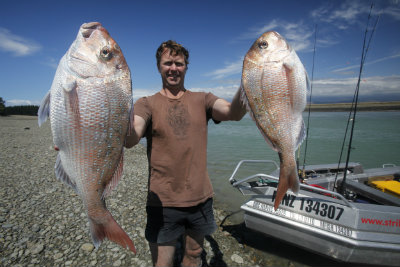
Big feed: Scott Mirfin with two large snapper caught this week.
Snapper are a glorious fish. Fishing for them is a national pastime in New Zealand and without doubt they are our best known recreational fish species. With their pink, orange, and silver iridescent sides, deep body, spiny dorsal fin and Angelina Jolie lips , they are a treasure to behold.
Snapper (Pagrus auratus) are revered for their cunning, their strong throbbing runs when hooked on a line, and their high quality as a table fish. They are well distributed throughout New Zealand particularly in the North island and our own Tasman Bay is one of their South Island strongholds. Snapper do go down the West Coast but the are probably most common north of Westport, while on the East Coast they are rarely seen south of Kaikoura.
Snapper fishing on our back doorstep is probably the best it has been for at least three decades as the stocks rebuild after the commercial annihilation of the 1970s. my kids are seventh generation Nelson snapper fishermen and have caught so many pannie-sized snapper that they have become almost blase about the experience, expected success whenever we go out fishing.
when I was a kid, though, it was a different story because catching a snapper was a big deal. dad would take us out in his aluminium dinghy and we would do a lot of fishing between the occasional catching. Nowadays, with increased fish stocks, and increased recreational understanding of snapper habits, it can often be surprisingly simple to catch good numbers of fish if you know where to go and what to do.
In my grandfather Ken hill's day, it was as simple as walking along rabbit Island looking for the snapper tails poking clear of the water as they fed on shellfish beds, before casting among them and catching a sack full of fish to take home. but them came the pair trawlers, and the snapper numbers were decimated for more than a human generation.
We're very fortunate that the current snapper management is allowing stocks of fish to rebuild, although a 2003 Niwa report of Tasman Bay snapper suggested that there has been a significant loss of genetic diversity over the past 50 years. Tasman Bay snapper stocks are a small isolated population separate from the North Island and annual commercial catches during the 1960s and 1970s were often more than 100 tonnes, and peaked at 2720 tonnes in 1979.
By the late 1980s the total biomass had declined from an estimated 23,000 tonnes to less than 1600 tonnes but significant genetic diversity had been loss putting long-term survival and productivity at risk. It is fortunate today that the current total allowable commercial catch is significantly lower although political pressure is always present to increase the annual take.
These days most of the snapper are caught early in the season by commercial fishermen and for much of the summer, shallow inshore waters inside a line drawn between Adele Island and Pepin Island are the sole preserve of the recreational angler.
Anyone who has seen local boat ramps in action over summer knows just how valuable these snapper are to local anglers and the local economy as a whole. Indeed some overseas studies show that a recreationally caught fish can be worth as much as five times more value than a commercially caught fish.
Like skinning a cat, snapper can be caught many ways including nets, setlines, and spear-fishing, but then most satisfying way to catch them is on a rod and line.
Tasman Bay snapper can be caught off wharves, surfcasting from the beach, or fishing from boats and kayaks, and best of all the snapper are here right now.
fishing Tasman Bay with my brother Scott this week was a real treat. Being midweek there was parking available at the ramp and we had a great time harvesting some fine snapper dinners together.
Every spring and summer, snapper move inshore from deeper waters to feed and breed. This year they seem to be a little earlier than usual, with snapper even being caught off the Boulder Bank and Rabbit Island in October. They even seem to be staying in Tasman Bay waters later these days, and we caught them in June last winter not too far from Nelson city.
Maybe climate change is warming the water, who knows, but there is no doubt that snapper respond closely to environmental variables. The big floods in December 2011 pushed a lot more sediment into Tasman Bay last summer and the fish certainly seemed to stay out deeper perhaps due to inshore feeding grounds being silted up.
Snapper range between mid-water and the bottom, eating a variety of other critters, preferring shellfish, kina, crabs, worms, molluscs, crustaceans, plankton, jellyfish and small fish.
Interestingly in Sam Mossman's epic book Snapper - New Zealand's Greatest Fish, a highly recommended read for any keen snapper fisherman, it was found that fish constitute less than 10 per cent of a snapper's total diet. As Mossman noted, "that seems strange considering that baits used to catch snapper are often fish of some kind".
Mossman's book also holds other real gems of snapper information but my favourites are the historical records such as Captain Cook's crew regularly being unable to catch fish, even in a pristine and commercially unexploited fishery. Often they would have to buy snapper from local Maori to feed themselves.
Another interesting historical footnote was the superiority of the Maori stone-age circle hook made out of bone which outfished the European 'J' style metal hook.
Luckily these days we have a treasure trove of hooks and lures to pursue snapper with but probably the best way to consistently catch local shallow-water snapper is with bait and burley fished down near the bottom.
Small boats have an advantage being quiet at anchor, casting a smaller shadow, and being mobile enough to fish difficult to access locations. it's no surprise that kayak fishing has become so popular nationwide and a recent kayak fishing seminar I attended at the port was packed with anglers keen to learn about the new fishing phenomenon.
Reading fishing magazines these days, you could get a warped perspective of what equipment you might need to catch a snapper, with images of big boy's toys with hundreds of horsepower and electronic gadgetry up the gazoo, all the rage in the desire to sell advertisers products. But i can confidently advise you that shallow-water snapper don't care.
They are an alert and cautious prey, run by instinct, and operating to the cycles of nature. In my experience, snapper can be consistently caught by fishing at the change of light, at half tide in-or-out, and by using burley made of minced fish, shellfish, or a commercial alternative.
We've also been most successful using lightweight sporting rods with braided line, circle hooks, ultra-light sinkers, and lashings of patience. I'm not a believer in driving around in the boast looking for fish with a depth sounder because in shallow water snapper will scatter like quail, scared by boat shadow and engine noise.
Stealth is always the best strategy in shallow water. Fish good locations at the right times with the right methods. Let the snapper find you this summer and you will catch many tasty fish dinners to share.
Saltwater fishing, Current Basin, Marlborough Sounds
Zane Mirfin, Wildside Column, Scouts' motto rings true in the outdoors, Nelson Mail, 26 January 2013
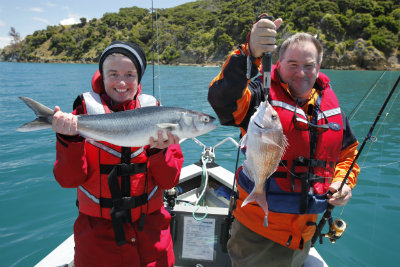
Good catch: Taranaki pair Ruth Profitt, with a Kahawai, and Dennis Gooch, with a snapper, when the sea was calm and the fishing was good.
In life, things very rarely always go to plan. It's inevitable that even the best laid plans will change, go pear-shaped or even turn to custard. It's no different with fishing and hunting and you need to be able to roll with the punches, adapt, improvise, and innovate when things don't turn out as expected.
Being out fishing and hunting all the time, I have my fair share of things that don't go as planned but usually it works out OK in the end. Scout movement leader Lord Baden Powell had an especially powerful motto that has stood the test of time - "be prepared".
I've always subscribed to the view that if you venture into the outdoors you need to have the means to get home safely. Attention to detail is important in checking the conditions, having appropriate safety equipment, making wise decisions and making sure someone knows where you are.
As a commercial operator, I've found that bureaucrats are always keen to check systems and processes to ensure health and safety aspects are met but it's pretty difficult to legislate against stupidity. Most recreational accidents in the outdoors are often avoidable with some planning, forethought, and common sense and I've always believed that many of the unnecessary rescues performed by emergency services should be paid for by the individuals concerned.
Adventure is where you find it and lately we've had our fair share. Last month, a mate and I were heading back to base after scalloping at Ketu Bay in the outer Marlborough Sounds, when my outboard motor started playing up, not having full power. Being a relatively new motor, just recently serviced, this was a real worry, especially when we were so far from the boat ramp at Elaine Bay.
Luckily a big commercial vessel was also dredging Ketu, and I pulled up alongside for some advice. We talked and tried a few things but the skipper gave me good advice.
"Your motor is running OK, I don't think we should try to take it apart at sea. You've got an auxiliary motor, marine radio and satellite phone. The sea is flattening off so head back now. It'll be a long ride home."
We did as suggested and later the big boat chased us down to check on progress. With a thumbs up, a grin, and a wave, the skipper swung the big boat around and headed back out to sea. Close to three hours later we made it back to Elaine Bay, managing to catch a few barracouta trolling on the way home.
That night at Okiwi Bay Holiday Park, proprietor Ian Montgomery kindly took a look at the motor for us. Methodically working his way through the options, Monty figured out the problem. Draining the carburettor, he tasted salt crystals in the fuel. Flushing some fresh fuel through the motor and replacing the carburettor drain bung, the motor roared to life.
We appreciated all the help we'd been given and I'd learned a new trick in case it happened again. That's how you learn in the outdoors, through experience, but also with the help and advice of others.
When it comes to boating I've always believed that the most dangerous part is driving there in the vehicle and getting the boat in and out of the water.Taranaki and the weather report was terrible, with 30 knot norwesters forecast. With the help of brother Scott, I planned where to escape the worst of the Marlborough weather and wind and we set out with high hopes. My people had great fishing, putting plenty of blue cod, snapper, kahawai, and gurnard in the cooler.As we headed for home, the sea conditions really deteriorated and the wind direction had changed significantly despite the forecast. Where we had launched the boat off the beach there were now big waves pounding the shore. We all had waders and lifejackets on and carefully planned how to get the boat back on the trailer.
Ruth and Dennis held the boat into the surf while I backed the trailer down the beach. Taking a side each they carefully lined the boat up while I hooked on the winch rope and manned the winch. Halfway on we were looking really good, until a really big wave came out of nowhere and slammed over the back of the boat, completely swamping it.
Everything was floating out and my first thought was that we were in trouble. Luckily we had all the angles right and the big sea kept pounding the back of the boat and pushing it up the trailer while I kept getting a few more turns of the winch handle.
The boat was too heavy to winch completely on but I was able to leap back in the truck and drive a few feet up the beach where we could drop the duckbills to drain the boat, and use a bucket to bail.
Getting the boat on the trailer wasn't the end of the adventure though as the tide was right in and we lost traction in the thick sand at the top of the beach.
With no run-up on the hard sand we got bogged, even in low four-wheel-drive. I ended up unhooking the trailer and anchoring it to the beach while we used pieces of old carpet to get traction and get the truck free, from where we could tow the trailer up the beach on a long strop.
Finally when we were all good to go we joked that our little misadventure was the best part of the day. In retrospect I should have had all my recovery straps and beach treads with us at that remote spot.
If I'd had my plastic fenders with us we could have also rolled the 4m boat up the beach out of the surf for a safer recovery. But it was a lesson well learned and you always need to carry all the gear with you at all times.
Little incidents happen in the outdoors all the time and you always need to be vigilant.
In the past week or so I had the propeller jam in a surging Lake Rotoroa when we pushed off in high waters after landing a trout, and a toi-toi bush wrapped around the blades.
Another day I was repairing waders and had leant a long wooden extension ladder against the house which I hung the waders on by their straps so I could fill them with water to locate the leaks. One minute I was on my knees marking the leaking waders, the next second the ladder slipped with me under it and I got flattened.
Luckily I took the full weight across my shoulders and back, and only came away with only a few bruises. That was pretty dumb and I definitely won't do that again. Sometimes anglers are more of a risk to themselves than the elements or their equipment.
This week got me thinking about other safety procedures like always wearing sunglasses to protect your eyes against flying projectiles. One day recently, I had a couple of poor casters ricochetting tungsten beaded flies off the aluminium boat. In the past I've even been whacked with heavily weighted flies on errant casts and it can feel like being hit with a .22 bullet.
People can even hook themselves. Some days I feel like a modern day Jack the Ripper lancing blisters and ripping out hooks. I've become a bit of an expert at removing hooks, with some strong cord around the bend of the hook and pushing the eye down to keep the barb on the correct exit level before pulling with force.
It works really well and it helps to carry all the gear you might possibly need in the truck for every occasion. During the years our equipment has mostly saved a lot of other people that we've come across, either to jumpstart their battery, tow them out of a ditch, or make an emergency call with the satellite phone.
The last people we helped were a young Israeli couple, who I gave a box of matches to when they had no means of firing up their gas cooker on a wet stormy night on the side of the road.
The storage box in the back of my truck carries a proven selection of gear that comes in handy from time to time with items like a machete, winch, heavy duty jumper cables, insulation tape, first aid kit, spare fishing gear, tyre valves, fuses, and tow rope.
You never know what you may encounter outdoors and like Lord Baden Powell said, it pays to be prepared.
Trout Fishing in Wild Weather
Zane Mirfin, Wildside Column, Wild weather can make for some great fishing, Nelson Mail, 12 January 2013
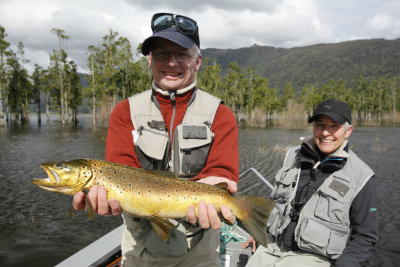
Caught: Maurice Perret and Senta Eschler of Switzerland with another "golden beast of the flooded forest" at Lake Poerua, West Coast.
One week recently we had heat waves, urban water restrictions, low rivers and high water temperatures. The next week we had heavy rains and flooding further south, followed by high winds, cold blustery conditions, lightning, thunderstorms, and even snow on the mountain tops.
Everyone knows New Zealand has a volatile mix of extreme weather, partly due to a maritime climate situated on the edge of the Roaring Forties. But after choosing to work outside and stand in the weather and rivers for the past 27 years as a professional fishing guide, I'd have to say the weather does appear to be more extreme than we ever had to deal with in the past.
Climate change sceptics abound, but I'm not one of them because I've personally stood in the water, got wet and watched the changes. Watching the TV news and reading the paper reinforces the changes with floods, mudslides, hurricanes and snow storms regular fare in global media reports. Interestingly, 2011 was a disaster for insurance companies, with Lloyds of London especially hit hard by record catastrophe claims in a year of earthquakes, floods and storms. Personally I don't feel too sympathetic for the insurance companies though, because in the end it is the taxpayer, ratepayer and individual who always pays.
My belief is that Mother Nature will continue to challenge humanity and that extreme weather is here to stay. The best thing we can do into the future is to stay out of the way of our rivers and oceans. Fortunately, technology has allowed outdoor people to cope more effectively with the extremes Mother Nature can throw at us.
Accurate weather forecasting, satellite imagery and modern communications have allowed us to check out what's coming and allow us to plan where to go, when and what to avoid.
With experience you can hunt or fish in any extreme weather situation once you understand weather patterns, river catchments and wind directions. In fact, some of the best results can be obtained in extreme conditions when no-one in their right mind would be out there. You'll have no competition and the fish and animals will have their defences down, often making them an easy target.
Modern equipment also helps with breathable Gore-Tex waders, thermal clothing, waterproof dry bags and premium raingear all helping to keep you warm and dry even in volatile and inclement conditions.
Fishing in the rain is totally possible and I much prefer it to fishing in extreme wind conditions. Further south from Nelson and Tasman, there are often two fishing choices - cope with rain on the West Coast or brave the dreaded nor-wester wind on the east coast.
If you choose to fish in the rain you'll eventually get wet, no matter how good your gear is and you always need to exercise caution being near rising rivers. Often the best strategy is to avoid fishing in the worst of the weather and making sure you're in position to capitalise on the conditions as the weather improves and the rivers fall. During the absolute worst of the weather, game and fish often seek shelter as the barometer plummets and rivers rise, and it can be a big ask to produce miracle catches in low atmospheric pressure conditions.Ad FeedbackHeadwater fisheries are the first to clear. With steep catchments and forested slopes, they rise fast and drop fast. Lowland streams take longer to clear, but different catchments vary and there's always hope at the confluence of clear flowing tributaries, spring creeks, and backwaters. Lake fisheries are especially good after torrential rain, as flooded margins provide a feeding bonanza for hungry trout. A boat is best to access these places as you can avoid dangerous wading through mud, weed, and channels of unknown depth to access trout patrolling the flooded margins.
Last week we had a marvellous adventure with Swiss angling couple, Maurice Perret and Senta Eschler. Fishing around Nelson Lakes area we encountered bad weather, bleak conditions and high rivers, but the fishing was great.
Bad news then when Steve Anderson of St Arnaud showed us the weather forecast for following days. The Milford track had already been shut with trampers trapped by rising floodwaters and the rain storm was headed north with high intensity extreme rainfall predicted.
We had two fishing choices - either stay put and ride it out or to drive through the worst of the storm and position ourselves for clearing weather behind further south. We chose the latter and what a drive. Like something out of Mr Toad's wild ride, we headed west into increasing rainfall. The Owen was on the point of blowing out, the Mangles was full and black and the Matakitaki was high and muddy. Following the twisted and tangled gorges of the Buller gorge, we followed the route of explorer Thomas Brunner as rivers exploded before us.
The Inangahua river was huge, and little did we know that roads were being closed all over the South Island due to extreme flooding, slips and even bridges blowing out.
It was a real adventure to experience the full fury of mother nature as she threw everything at the environment. Rain splashed off the road, waterfalls appeared on hillsides and cascaded over the road. Hawks Crag on the lower Buller was especially impressive, with water surging off the hillside creating a virtual tunnel as the river raged below. Later the road closed behind us, with several large slips trapping motorists.
At Punakaiki we were the best dressed people around as our Gore-Tex waders and raingear kept us warm and dry, while the rain pelted down and the wind howled. The coastal storm surge was huge.
"Unbelievable" as Maurice kept repeating. The blowholes and pancake rocks were at their finest, as the rain being driven sideways forced surges of water into the limestone cavities.
At Greymouth, we marvelled at what we had experienced over a fine meal and beers at the Speights Ale House, while it continued to rain cats and dogs. Outside we debated the sanity of crossing the road to the vehicle in the torrential deluge.
Next stop was Moana township at Lake Brunner, passing by flooded farmland under sheets of surface water from rain and nearby creeks and rivers. Overnight my boat continued to fill with water and even though I had the bungs open there was still stuff floating there in the morning. But the worst had passed and we were in "the zone". Brunner was high, though we were optimistic as the sun came out but unfortunately so did the clearing SW gales.
We found sheltered water amongst the flooded kahikatea forest and sodden pastures. The fishing was awesome with cruising trout hungry for our flies. Perhaps the biggest challenge was avoiding all the fences, as I rowed and spotted trout about three paddocks back from the normal lake edge.
It was special fishing and later that afternoon we switched lakes for some variety, fishing Lake Poerua into the early evening as the trout fed on. Navigating the boat through narrow avenues of kahikateas, avoiding fences, and casting to visible trout capped off a classic day.
The floodwaters were dropping now and we would have great fishing over following days on headwater streams and helicopter access waters. Yet, my favourite moment of the week came at the boat ramp celebrating with a beer as Maurice enthused, "We have caught the golden beasts of the flooded forest."





